

0 92 > $14.95 US 71486 29217 3 H O N O LU L U LO S ANGE LE S B AL I LA S VE GA S O S A K A
A symbol of love, friendship, appreciation, and aloha.
For generations, the people of Hawai‘i have used lei to express these emotions, strengthen relationships, and show gratitude. Our roots are set in the islands and, as in the human gesture of gifting someone a lei, extend outward.
FOR THE LGBTQ TRAVELER

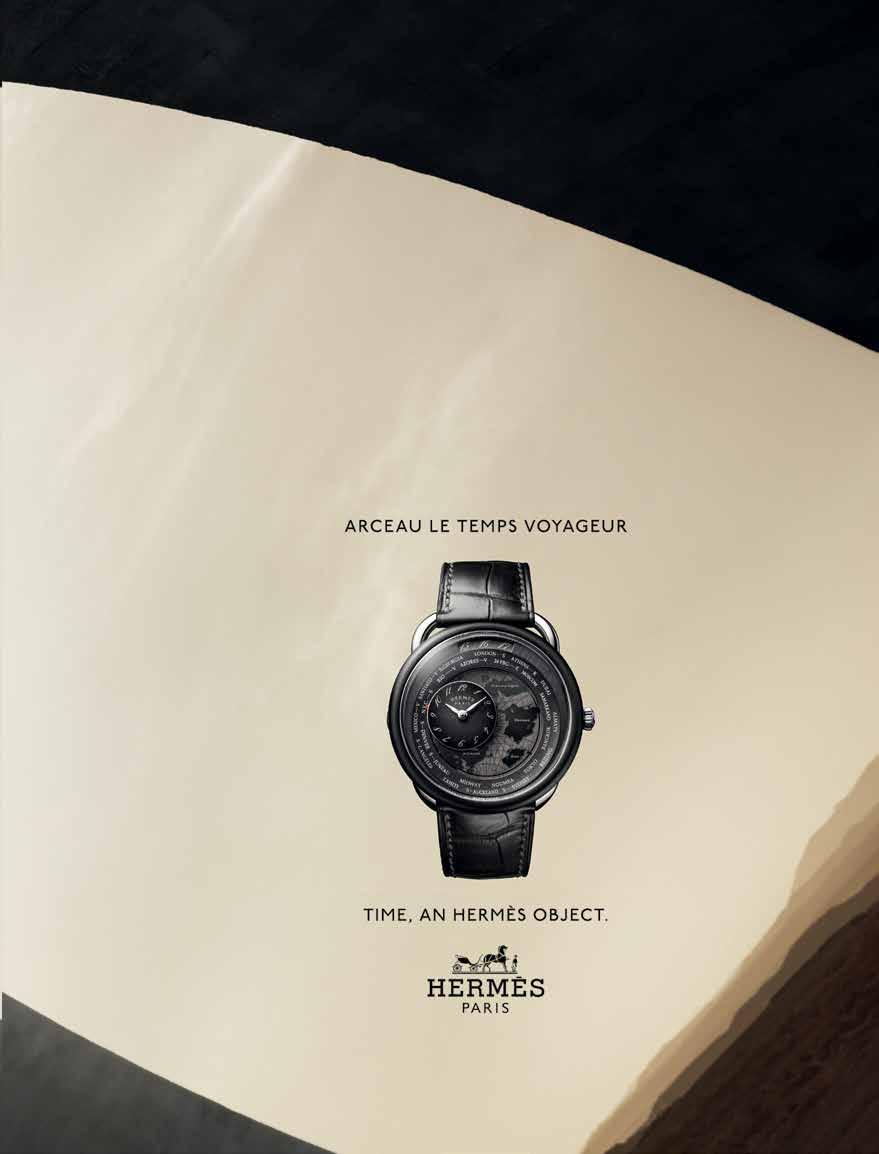


If you haven’t visited Las Vegas recently, Sin City is thriving during what it calls another roaring ‘20s, with new hotels, bars, restaurants, shows and attractions.
Photo: The Cosmopolitan of Las Vegas
MASTHEAD
President & CEO
JASON CUTINELLA
Publisher
Partner/GM - Hawai‘i
JOE V. BOCK
VP Brand Development
ARA LAYLO
Global Editorial Director
BRIAN MCMANUS
Editor-In-Chief
VP Global Brand Storytelling
MARC GRASER
Contributing Editor
JOSHUA GLASS
Editorial Director
LAUREN MCNALLY
Editor-At-Large
MATTHEW DEKNEEF
Digital Editor
EUNICA ESCALANTE
Designer
TAYLOR NIIMOTO
Digital Content Manager
BRIGID PITTMAN
Photography Director
JOHN HOOK
Contributors
TRISH BENDIX
EUNICA ESCALANTE
EVAN ROSS KATZ
MAGGIE LANGE
KEN SCHULTZ
JESSE SZEWCZYK
Images
ASHLEY BAT
KELLI BOYD
CODY JAMES
XAVIER LUGGAR
GRAY MALIN
SAM MULLER
ZOE RAIN
CHRIS ROHRER
VP Film GERARD ELMORE
Filmmakers
BLAKE ABES
ROMEO LAPITAN
ERICK MELANSON
Video Editor
JHANTE IGA
Brand & Production Manager
KAITLYN LEDZIAN
Brand Production Coordinator
TAYLOR KONDO
Head of Sales
KRISTINE QUINE
VP Sales
MIKE WILEY mike@nmgnetwork.com
VP Integrated Marketing
FRANCINE NAOKO BEPPU
VP Accounts Recievable
GARY PAYNE
Account Executive
NICHOLAS LUI-KWAN
Marketing & Advertising Executive
COURTNEY ASATO
Sales Inquiries
SALES@NMGNETWORK.COM
Published by
36 N. Hotel St., Suite A Honolulu, HI 96817 nmgnetwork.com
©2022 NMG Network. All rights reserved. No part of this publicati on may be reprinted without the written consent of the publisher. Opinions are solely those of the contributors and are not necessarily endorsed by NMG.
ISSN 2578-210X
6

Tokyo may be more well known, but Osaka should be high on your list when visiting Japan, because of its vibrant cultural scene, outgoing locals, and world-renowned food scene.
OCTB
 Photo:
Photo:

COMMUNITY
20
Melissa King's Signature Dish
28
Sam Lansky’s Love-Hate Letter to Los Angeles
36
Tadd Fujikawa’s New Sport to Master
CULTURE 52
Photographer Gray Malin's Whimsical World
62
Keala Kennelly Rides Against the Current
70
Kenneth Nicholson’s Romantic Masculinity
EXPLORE
88
Featured Destination: Viva Las Vegas
98
Live & Loud in Las Vegas with RuPaul’s Drag Race Live!
108 Finding Love in Bali
42
Donté Young is Bold by Design
76
Coast to Coast with The Dragon Sisters
116
Featured Destination: Japan's Capital of Cool
124
Kiki’s Sukezane’s Role of a Lifetime
136 Waikīkī’s Lady in the Water
TABLE OF CONTENTS 10


Lei TV offers a curated guide to Hawai‘i and other welcoming destinations for the discerning LGBTQ traveler. Its episodic series share diverse stories about the places, passions, and people who make the world unique and worth exploring.
Community
Meet the filmmakers behind Colors of Kaua’i, a touching documentary about Kaua’i’s first Pride parade. Get a behind-the-scenes look at the drag queen divas of The Party Monsters show. Go baroque at the Honolulu Museum of Art with the lavish costumes of designers James Corry and Evans Siskel.
Culture
Gain a greater appreciation for bisexual women through a revealing portrait of six members of this often misinterpreted community. Taylor Okata takes on New York’s fashion scene. The L.A. Dance Project taps into the creative range of its host city to expand the boundaries of dance.
Explore
If you’re seeking escapism, Las Vegas never disappoints and is ready to titillate with refreshed hotels, exciting new entertainment options and over-the-top experiences. Or how about Osaka, a charmingly queer-friendly city that we’re heralding as Japan’s “Capital of Cool” for its first-rate attractions, including Universal Studios Japan’s Super Nintendo World.
12
ONLINE Discover stories that celebrate LGBTQ communities online at leiculture.com WATCH ONLINE AT: nmgnetwork.com/leitv instagram: @leiculture twitter: @leiculture facebook: /leiculture

Aloha,
LGBTQ traveler.
If there’s a theme that runs through this issue of Lei, it’s the power of place as a source of inspiration to the LGBTQ community. Where we are can often define who we are, and we’ve gathered stories about some of the most creative and passionate voices who make us rethink what it means to view the world in new ways.
From Las Vegas to Osaka, Japan, Bali to Los Angeles, we have also chosen to celebrate the places that truly value the LGBTQ traveler — destinations that don’t just unfurl the rainbow flag once a year, but make us feel safe and seen year round. Never before has inclusiveness been more important than now and, as the world opens up again, it’s time to pay attention and reward those who pay attention to us.
To all of Lei’s new and existing fans, Hawai‘i will always be our home, and powerful attributes of aloha — love, kindness,
compassion and respect — will always serve as a guide for how we want to grow Lei as a travel brand that’s dedicated to exploring the most welcoming destinations for queer travelers.
We certainly live in turbulent times. But with travel, you can escape the norm and find the best in people or rediscover a place you think you already know.
Keep visiting LeiCulture.com and watch Lei TV series like The Lei Over, Lei Escapes, Lei Exchanges and City Pride for stories that will help you travel better and enable you to be your most sincere and authentic self.
Safe travels,
Marc Graser Editor-in-Chief
@leiculture leiculture.com
LETTER FROM THE EDITOR 14
and mahalo for reading Lei, our voice for the


MELISSA
Melissa is a freelance writer based in Brooklyn, NY, where she lives with her wife and rescue dog. She's contributed to The New York Times, Wall Street Journal, New York Magazine, Conde Nast Traveler, Eater, Thrillist and many more publications.



Trish Bendix is a writer and a New York Times contributor based in Los Angeles. Her work has appeared in The Wall Street Journal Magazine, Time, Variety, Vulture, The Cut, The Daily Beast, Conde Nast's THEM, Cosmopolitan, Vogue.com, ELLE.com, OprahMag.com, HarpersBazaar.com, The Hollywood Reporter, Nylon.com, LAmag.com, NBC Out, Slate, and Buzzfeed, among others. Bendix is the former editorin-chief of AfterEllen and managing editor of INTO, a digital LGBTQ magazine. She has essays in the Seal Press anthology Dear John, I Love Jane and its sequel, Janeland (Cleis Press), More Than Marriage (Ooligan Press), Opposing Viewpoints: Celebrity Culture (Layman Poupard Publishing), and 2 Brides 2 Be (Archer).
Born and raised in Kalihi Valley, Mahinahokukauikamoana Choy-Ellis (she/her) is a Kanaka photographer who picked up a camera at 12 and never put it down. After eight years in New York City, Mahina felt the call to return back to Hawai‘i and has since found creative support from the Lāhui and Māhūi, finding her main inspirations from both. With a curiosity that knows no bounds, Mahina and her camera can be found spending time with subjects from professors to Drag Queens, and is grateful for every journey each photograph leads her to. She is mother to four cats: Miso, Matcha, Botcha Boy and Baby Girl.
Author, poet, and serial creative Dakota Adan calls the beaches and sprawling cities of Southern California home. Having traveled to over 30 countries as a performing artist and writer, his work has been featured in magazines, on stages, and by brands both at home and abroad. His debut collection of poetry, Be(loved), quickly became a best-selling work online with critics praising Dakota and his work as a radical permission slip to feel.
CONTRIBUTORS
KRAVITZ HOEFFNER
TRISH BENDIX
MAHINA CHOY-ELLIS
DAKOTA ADAN
16
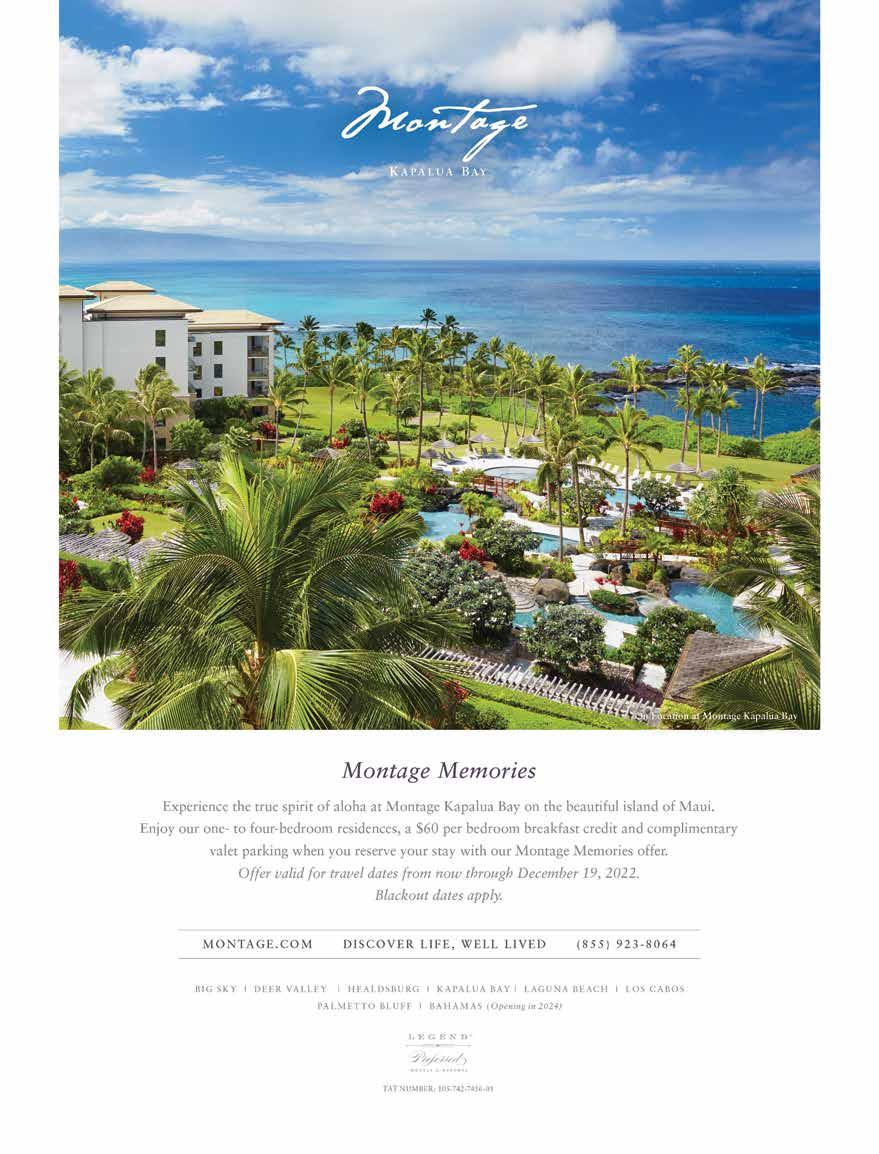

I. Community
Face to face with
those who hope to open up the conversation on identity and community
The cult-culinary hero and Top Chef All-Stars winner’s recipe of lobster wontons in yuzu broth is inspired by community building and nostalgia.
Melissa King remembers practicing folding wontons at an early age. “As a kid I would sit around the dining room table with my family learning to create dumplings,” she recalls. The intricate tradition is one that the chef has carried throughout her professional career since, cooking for intimate parties of 10 to groups upwards of two thousand. One of her wontons, infact, helped her win Top Chef All-Stars, with the competitive cooking show’s judges describing King’s plated product as “stunning.” Another—her signature recipe of lobster wontons in yuzu broth with scallion oil—is not only delicious but also tells the story of her home.
“It’s a dish that started as an idea from something I ate as a child,” says King, a Cantonese-American Cali-native, who grew up in Los Angeles, where her parents migrated from Hong Kong, and currently lives in San Francisco. She studied at the Culinary Institute of America, graduating at the top of her class, and has trained in numerous Michelin-starred kitchens, including the renowned Campton Place and Luce. The chef has cooked for celebrities like Oprah and recently curated the menu this year at the Metropolitan Museum of Art’s infamous Met Gala. And so King’s signature recipe blends this impressive culinary background with the essence and tradition of her early memories. “It’s something that’s new and different and exciting.”
To make the dish, King starts with a homemade broth that draws inspiration from Japanese cooking. She slowly simmers a bounty of umami-rich ingredients together from bonito flakes to kombu to create a savory stock that resembles Japanese dashi. King then strains the broth and seasons it with soy sauce, mirin, and a touch of butter for richness.
20 TEXT BY JESSE SZEWCZYK IMAGES BY ASHLEY BATZ MELISSA KING'S SIGNATURE DISH

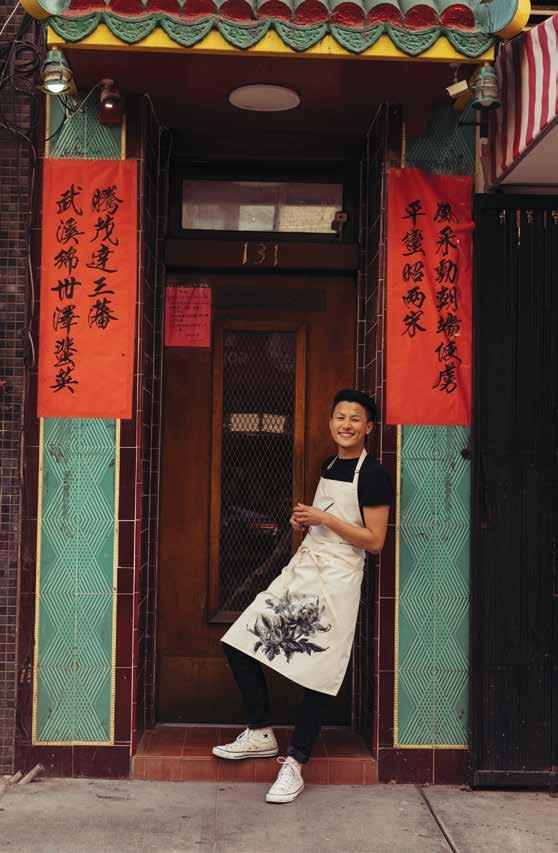




For the finishing touch, the chef draws on yuzu—a sour citrus fruit prized for its alluring fragrance—to bring complexity and brightness to the broth.
But it’s with the star of the show that King’s true personality shines. A departure from the traditional shrimp or pork, the chef packs her dumplings with lobster, each of which are filled and then delicately folded by hand. According to their maker, the practice is labor intensive and takes time. Having a crowd of helping hands is key: “It’s really something that brings everyone to the dinner table.”
This act of togetherness fosters the sense of love and community that is reflective of the chef’s work outside of her kitchen. King is passionate about supporting her community and works with organizations including the Human Rights Campaign and Stop AAPI Hate. After winning Top Chef’s coveted fan-favorite award, she donated the entirety of the ten-thousand-dollar prize to charity. Given the philanthropic nature of her work, it’s no surprise that those same messages of love and generosity are felt through her cooking. “Anything that you make with your hands is always special,” she explains. “It takes a lot of effort and love.”
Finishing off her creation, King nestles her wontons in the broth and drizzles a charred scallion oil over top for further enlivenment. Depending on the occasion, she tops each wonton with a crowning of caviar to add a celebratory salty bite. It’s a dish that King calls heartwarming; one that symbolizes the soul of her childhood and celebrates her community.
26

Sam Lansky’s debut novel is driven by an endless fascination with Los Angeles that can only come from sincere love.
There’s an impeccable scene in Sam Lansky’s satirical novel about Los Angeles, Broken People, in which two men prepare to meet a shaman who has promised to transform their lives in three days. They are set-dressing their environment: They’ve acquired a gorgeous yurt (“ranch-hand glamour”) with Pendleton blankets (“masc seeking masc”), some medium-sized House of Intuition crystals, and Candle Delirium lighting. They debate which store will carry “the best selection of stylish buckets that will fit our aesthetic.” The buckets are, of course, to vomit into when the ayahuasca takes hold.
There’s no better place than Los Angeles, Lansky’s novel posits, for the most fashionable trappings of healing. Broken People shows a city caught in the “crosshairs of materialism and mysticism,” as Lansky describes over the phone from his West Hollywood home on a sunny day in early January. In the book, the men beautifying their spiritual yurt are scolded by the shaman for “trying to produce the experience.” They’re taking an almost competitive approach to healing. The very impulse to make everything look gorgeous and seem vibe-y, the very impulse to heal everything away, is exactly what Broken People wants to address. The book holds a mirror to this wellness-chic impulse, cracking the mirror in the process.
When Lansky, a magazine editor and journalist, was in his early 20s, he wrote a memoir about his teen years in New York.
TEXT BY MAGGIE LANGE IMAGES BY CODY JAMES MAN ABOUT TOWN 28




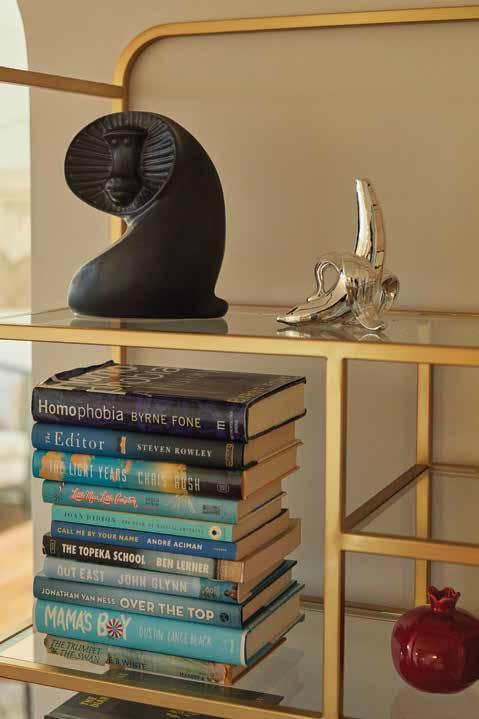

Published in 2016, The Gilded Razor details the trajectory and fallout of Lansky’s drug addiction. A few years later, Lansky published Broken People, his first novel, which, to an extent, picks up where the memoir left off.
In the novel, a magazine editor named Sam (who wrote a memoir about his years of addiction) is at the center of the story. This personal tether is potent throughout Broken People; while it is ultimately a juicy satire full of fun, absurd characters, the book also has a strong, pumping, very real heart at the center of it. Lansky jabs at L.A.’s hypocrisies and contradictions, but he never forgets that there’s an earnest impulse in this relentless selfimprovement. In its cracked mirror, it also reflects the author’s fascination with and love for the city.
“I have become, for better or worse, a very L.A. person,” Lansky says, “and this is a very L.A. book.” When I ask Lansky what he means by “very L.A.,” he answers snappily, “I have an Erewhon sweatshirt.”
At first, he says, he was entirely bemused by the famous grocery store, with its “$22 yogurts” and clientele that’s “either rich or famous or both.” Quickly, bewilderment shifted to genuine affection. Now, Erewhon is his favorite place, he says, and he’s completely lost track of when ironic participation turned to earnest devotion.
“A place where anyone could be their best self for a price is so compelling to me,” he says with a laugh. For example, he was amused to find himself suddenly interested in Los Angeles’ footwear culture. “In New York, I did not have a single pair of bougie sneakers,” he says. “I’m not a sneakerhead wandering Fairfax, but I do have a number
of sneakers that cost more than anything else I’m wearing. I still feel cool with some very chunky, very ugly Balenciagas.”
In a place famously obsessed with outer beauty, he loves when the worship of beauty is whole-heartedly rejected in a flash of independence. “I have so much respect for fashion-y ugliness,” he says. “You see it architecturally too, with this horrible, squat Brutalist architecture.”
While L.A. denizens may instinctually make everything into a gorgeous production, may stylize a yurt for their spiritual improvement, Lansky also sees some radical self-acceptance in their moments of free, fun, fashionable ugliness.
This perspective positions Lansky to address the cultural moment perfectly. Perhaps the most moving moments in Broken People are when Sam Lansky the writer shows you exactly how absurd something can be, but Sam the character falls for it anyway, because, in Los Angeles, it’s also totally irresistible.
34

On a barrier island off the Georgia coastline, the world’s first publically gay golfer celebrates peace of mind—and pickleball.

TEXT BY KEN SCHULTZ IMAGES BY KELLI
BOYD
36
TADD FUJIKAWA FINDS HIMSELF
Tadd Fujikawa knows how to make headlines. In 2006, he captured the golf community’s attention when he qualified for the US Open at 15 years-old, setting a record for his young age. Then, in 2018, he became the first professional male golfer in history to come out publicly as gay. Now, almost four years later, Fujikawa is living openly as his authentic self. He’s stepped away from the course but found contentment in a new sport: pickleball.
“I’m just trying to enjoy life and learn to live aside from golf,” he says from his home on St. Simon’s Island in southeast Georgia. “Since I was 16 and up until the end of last year that was all I did: practice and play tournaments and travel. Having a life outside of that and making a consistent paycheck every two weeks is really nice.” Carved out over the past year, Fujikawa’s new path finds him a pickleball pro at the nearby Sea Island Resort.
It took quite a journey to get there. Born and raised in Honolulu, Fujikawa developed a love for the outdoors in his childhood. While he eventually made a name for himself as a pro golfer, he originally took up the sport because of his first love—judo.
From ages 8 to 11, he won four national combat championships, and golf was just a companion hobby to build up wrist strength. Entering his teens, Fujikawa needed to focus his time and had to make a decision about which sport to pursue full time.
Golf proved to be the right call. After qualifying for the PGA at age 16, Fujikawa spent years focusing on his golf game but to the exclusion of other parts of his life. “It was hard to figure out who I was,” he reflects now, realizing he didn’t have the time then to come to terms with his identity.
“It took me a long time…many years to figure all that stuff out.” When you’re a young pro, golf isn’t the relaxing activity that it is for others.
Fujikawa soon fell into a depression and after a few years it became so profound that it began affecting his athletic performance. He went into a deep slump that lasted numerous tournaments.



Fortunately, Fujikawa began to embrace his sexuality and the world around him started to improve. He remembers winning the 2017 Hawai‘i State Open as one of the most significant moments of his golfing career, declaring: “Through all of the lows and bad experiences and mental health issues, coming out on top was a big deal for me.”
Ironically, it was Fujikawa’s golf career that ended up playing a significant role in what became an intense and fulfilling coming out experience. One evening in September of 2018 he decided it was finally time, and through a simple post on Instagram he quietly revealed to his fans that he was gay.
The next morning the golfer woke up to numerous supportive texts and comments. It grabbed the attention of a sports writer, who published a story about his announcement online. News quickly took off, and Fujikawa still remembers his phone constantly buzzing every ten seconds.
Such an onslaught during one of the most emotionally vulnerable moments in one’s life could have been overwhelming, but the athlete’s experience dealing with media scrutiny helped keep him grounded.
Plus, as he remembers now, “Because a lot of the press was very positive about it, it made me feel good. And my family was on board and they supported me. That really helped.” As the week went on, the tidal wave of positive responses Fujikawa received proved to be one of the most uplifting parts of coming out in such a public way.
“When most people come out, [they] hope for the best but always expect the worst. And for me, it was very pleasant,”
he says. “A lot of positive feedback…it’s been amazing.”
From there, Fujikawa was able to use his public platform to help many others in their own coming out processes and to this day, he remains grateful for the opportunity.
Fujikawa believes he’ll eventually play golf again but at the moment he remains focused on enjoying this new life he has.
He’s thrilled about his pickleball gig, enthusing “I picked it up a little over a year ago, and I absolutely love the game! The people that play it are so fun, and it’s very social.” Along with the different sport and lifestyle, Fujikawa is also getting used to living with his boyfriend. “I think the saying that everything happens at the right time was very true for me,” he says. “Because if I had come out sooner, maybe the world wouldn’t have been ready for that. Everything does happen for a reason. I’m very happy right now with my life. I’m in a good place.”
40

Chicago-based interior designer Donté J.
Young crafts elevated spaces around the globe inspired by personality and his love for life.
A city can have a powerful impact on the work of an interior designer, and Chicago has certainly helped influence Donté J. Young’s “be bold, not basic” approach to creating captivating spaces.
“Chicago is the birthplace of incredible architecture and interior design greats,” says Young. “It has a skyline that is recognized worldwide and regarded accordingly,” born out of the largest building boom in the nation’s history after the Great Chicago Fire of 1871. “My style of design incorporates this city’s history and resilience. It's as fluid and beautiful as the banks of Lake Michigan that this great city rests upon.”
That means spaces that honor the old and the new, the traditional and the more avantegarde. “It’s not just a beautifully designed space, but an area that is experienced and one you become enveloped within,” Young says. “It transitions with you throughout the day, rests with you over time, and welcomes your friends, family, and loved ones.”
“Chicago is primarily cold during the year and can often be gray, so making sure the design is both beautiful and bright is key in getting everyone through the horrid winter months,” Young says. “While the third-largest city, Chicago is still very much the Midwest, so the feeling of home and comfort is essential in most simple or chic designs. This approach leads to a welcoming and warm overall design. Layering in various textures and architectural
TEXT BY MELISSA KRAVITZ HOEFFNER IMAGES BY ZOE
RAIN
BOLD BY DESIGN IN PARTNERSHIP WITH YOUNG & CO. 42

elements achieves a more luxurious and comfortable style while staying timeless and chic.”
Young has always had the finishing touch. Raised by his interior designer mother in Dublin, Ohio, he developed an eye for style at an early age. After studying architectural engineering at Ohio State University he made his way into the world of real estate by becoming a broker. But after the 2008 market crash Young was forced to pivot and moved to Chicago to take on a marketing role at Sotheby’s. When the luxury group sold its franchise, he found himself in a moment of uncertainty in a foreign place.
Unwilling to fail, Young looked to a growing network of affluent and highprofile clients to start a PR firm. A roster of health, beauty, and fashion names became a valuable asset for the booming company, and eventually Young sold the business to start a new agency in Napa, California, that paired athletes and celebrities with food and wine brands.
On the side he began to invest in real estate; decorating the properties himself and then renting them to top-tier clients. By the time the world changed again in 2020, Young was well established, getting regular solicitations for private design work, which prompted him to launch The Young Companies.
He has since partnered with Napa Valley artist Penelope Moore to create original paintings based on life’s specific moments. Young has also added Hospitality Partner to his CV at the Chicago-based Roaring Twenties Hospitality Management, where in addition to his own interior work Young oversees a team leading the design of
the soon-to-open INA Wellness, Real Authentic Wellness (R.A.W.), Dos Amores and Dos Tapas restaurant concepts.
But it’s Chicago — the first big city that Young moved to — where he finds a constant source of inspiration. “The architecture here is so phenomenal,” he says. “The skyline, the lakefront. It’s almost a sensory overload.”
Steps away from the Joffery Ballet, Chicago Symphony Orchestra, and Lyric Opera House, Young is constantly enthralled. “There’s so much to see and so much to take in,” he says. “There’s beauty around every corner.”
Young’s camera roll is full of local buildings and the flowers and beautiful details that he wants to incorporate into his designs someday. A plethora of hotels in his neighborhood offer both design inspiration and a constant flux of visitors with a range of cultures and styles.
Interiors for Young are as living and breathing as the people inside them. He’s transformed coastal mansions in Montecito, Calif.; grand homes in Florida and Texas; and downtown New York loft spaces and classically-luxe townhomes on the Upper East Side.
“Design isn't just paint or fabric swatches, it’s how someone inhabits the space,” he says. How is someone using their lighting and furniture? What do they want their home to smell like? Feel like, texturally? I don't shy away from bold patterns or big statement pieces. I make sure that if [my clients] grow tired of a design over time, they can exchange a throw or pillows or tablescape decor for a refresh without a total redo.”
For a recent project in Greenwich, Conn., Young transformed an 1800s-era shingle-
44


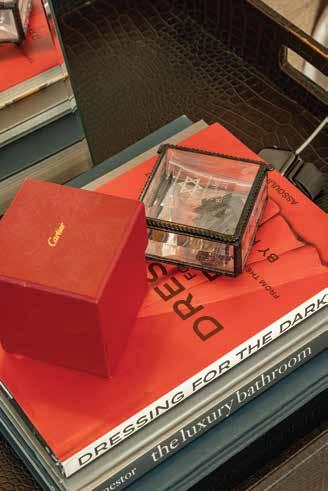
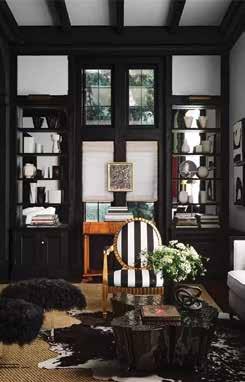
style New England mansion into a modern, welcoming environment showcasing the homeowner’s expansive art collection and love of technology while maintaining select traditional elements.
In another private home in Dallas, he blended a light, earthy palate with custom artwork and carpentry under a distinctive contemporary glass chandelier for fluidity and practicality with a dash of dimension and drama. This neutral coloration extends to the screening room, where layered textiles and natural wood serve as a portal to escape into a film and double as an informal entertaining space for guests.
These aesthetics are central to Young’s talent; merging the neutral with the outstanding and the practical with the whimsical to allow spaces to suit the lifestyles and desires of his clients. His own inviting Windy City home features a relaxing palette of brown, taupe and tan hues.
With his Chicago business flourishing, Young is excited to expand to New York City – another opportunity to reflect the city and its neighborhoods in his work. He’s always considered the city to be his second home.
“While Chicago was the first big city I resided in, New York will become my future and furtherment of Young & Co. Manhattan is a melting pot of culture, arts, design, music, architecture, fashion, cuisine, history, grit, and much more. Each neighborhood, from the Upper West and East Sides, Midtown, to Downtown, is vastly different but connected because it’s New York, baby. The energy of Manhattan ignites my design. It provides my team and me the opportunity to step out of the box a bit.”
When it comes to design, Young wants to embrace a more “boldly serene”
approach, and provide his clients “with a break from the hustle and bustle right outside of the door.”
“I am and have always been a downtown guy,” he says. “The various downtown neighborhoods inspire my design while throwing in classical elements of the Upper East and West sides. On the flip side, when designing for clients on the Upper East or West sides, we like to bring a little of downtown into those design concepts. It is a known fact that New Yorkers love their neighborhoods, so while many may not venture out of their hood too often, we look to bring different neighborhood elements into these designs.”
With forthcoming projects spanning Manhattan and the Hamptons to San Francisco and Dubai, Young is clearly in demand. He’s also ready to be as bold as he can be with projects that empower his eye for design.
“I don’t say no to things,” he says. “I steer clients in a different direction. I like things to be current but to also withstand the test of time. If you’re designing and spending money, you want to utilize that and design to mix and mingle.”
48


II. Culture
Exploring the creative arts, intellectual achievements and thought provoking beliefs of inspiring minds
GRAY
WHIMSICAL WORLD
BY GRAY MALIN
The fine art photographer has come a long way from selling prints out of a Fairfax Flea Market tent in Los Angeles.
Now a New York Times best-selling author, Gray Malin left a lucrative job in corporate America to pursue photography. It was a risky move, but his first series, Prada Marfa, was a huge success. Born and raised in Dallas, Texas, he staged and shot the faux fashion boutique slash art installation in the artist enclave of the West Texas town against a desolate highdesert backdrop. Photographs like Mule include a beautiful brown horse parked outside of the Prada outpost as if a customer had trotted over from a nearby ranch. Two Cowboys II shows its titular hatted stars atop their steeds, staring into the golden light of the glamorous shop’s windows.
The photographer’s work has since continued to play with viewers' expectations, creating situations saddled with irony and whimsy. The horses were just the first of many of his muses: Malin has gone on to feature exotic animals including penguins, elephants, giraffes, flamingos, and lions, all stemming from a fateful trip to Parker Palm Springs in 2015. The luxury mid-century California hotel is set on a 13-acre complex that boasts contemporary art and redesigns from Jonathan Adler, all of which gave Malin a colorful, playful space to realize his dream of shooting a monkey playing ping pong, a camel transporting luggage on his hump, and a parrot playing a round of golf on the green. Just to name a select few.
Shot in the early mornings before guests awoke to start their days, Malin's animalistic
TEXT BY TRISH BENDIX
IMAGES
52 Photography © Gray Malin www.graymalin.com @graymalin
MALIN'S

Parker series spawned several offspring after, with the photographer finding himself at other iconic hotels, including The Plaza Hotel in New York City and the Breakers Palm Beach in Florida. It was at the latter where a visiting yellow lab inspired an impromptu and important capture. “They shut down the front entrance for me,” remembers Malin. “I had like 12 models, everyone dressed in 1960s attire—it was incredible—and we ended up shooting a solo shot of just the dog. It sort of stuck with me.”
Malin went back to Los Angeles, where he lives with his husband and two children, with an idea for an all-dog shoot at the Beverly Hills Hotel. Small dogs, big dogs, classic, and symbolic breeds of all shapes and sizes became the inspiration for Malin, who found a new magic in placing dogs in otherwise human environments.
“There's just an incredible world within dogs,” Malin says. “It all started from an organic, natural approach to photography and something unexpected. Part of the great significance of being an artist is that you just never really know where [the art] is gonna take you.”
What began as a series of different sizes and breeds living a fantastical life lounging at the pool has now turned into what Malin is perhaps best known for, as his Instagram following can attest. “When I see these images with the dogs, it makes me laugh,” Malin says. “It makes me feel good. It's unexpected, whimsical art.”
Malin has shot man's best friend in wintery settings in Colorado, and at Aspen's The Little Nell hotel, as well as the beaches of Nantucket. More recently he has returned to Palm Springs for a series that became a hit during lockdown. He attributes its popularity to the pure joy that comes from seeing dogs enjoying themselves at the Parker's Lemonade Stand or a pair of dalmatians sharing drinks by the pool in a photo called The Perfect Spot While many of Malin’s fans have connected with his work because of its canine subjects and others the locations, for most it’s been the feeling of being transported—especially over the last couple of years.
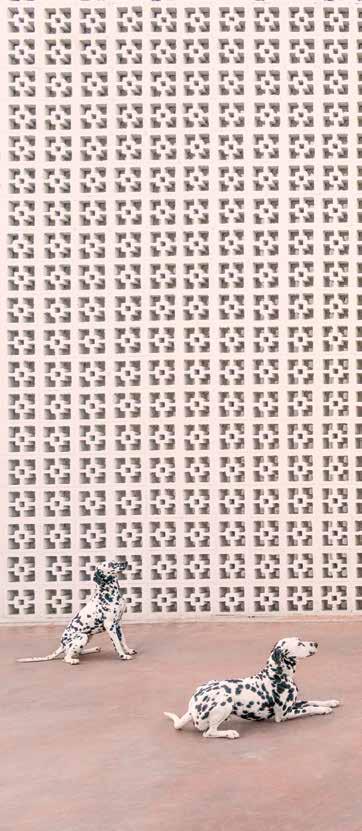
54
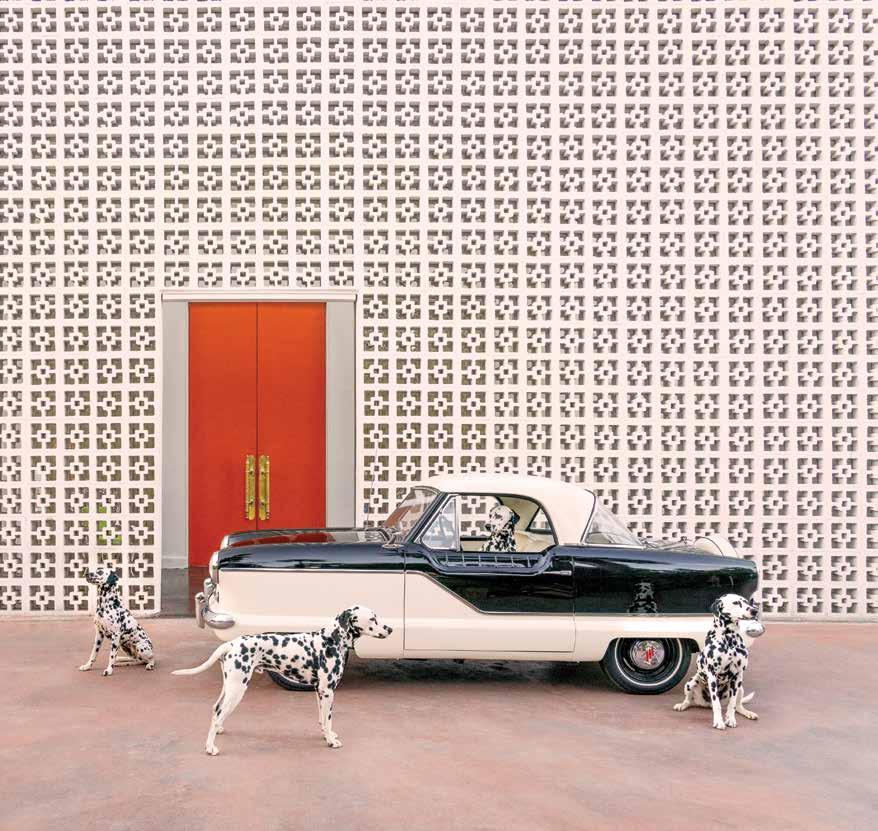

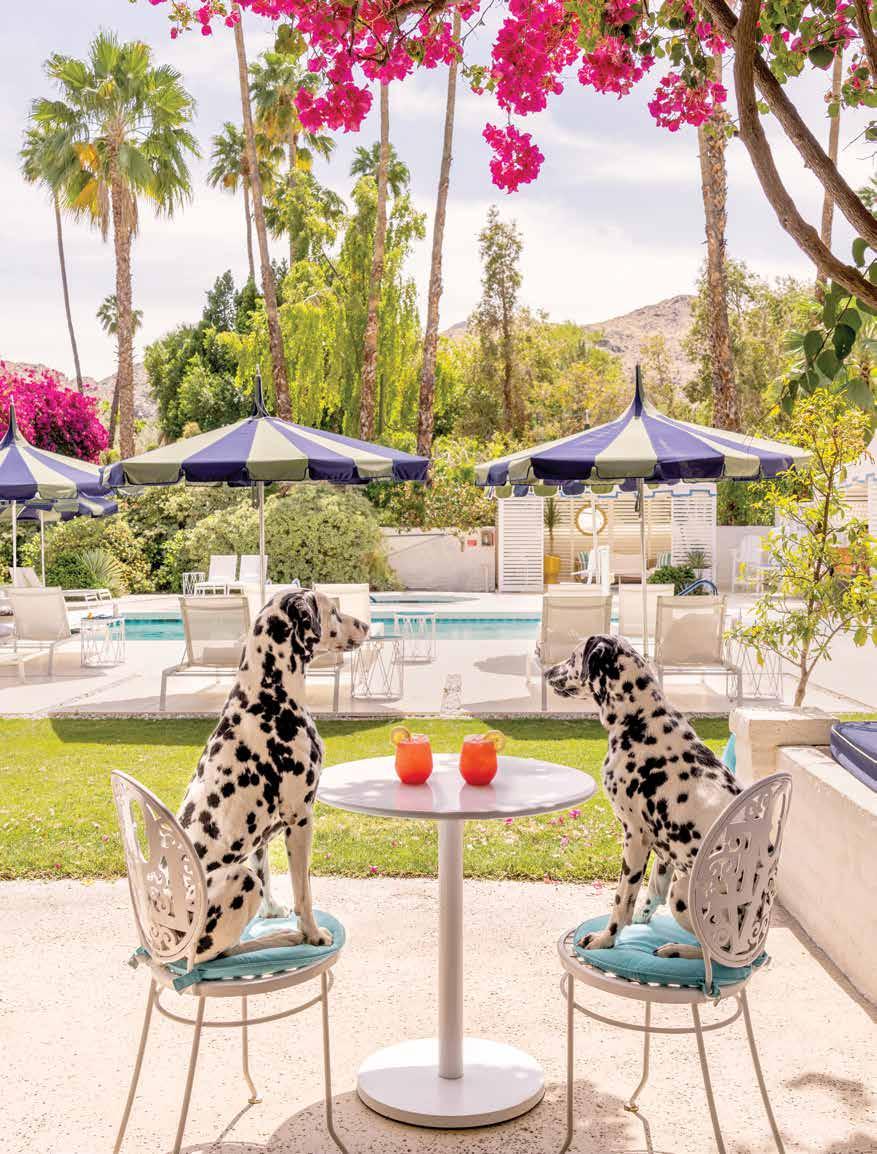

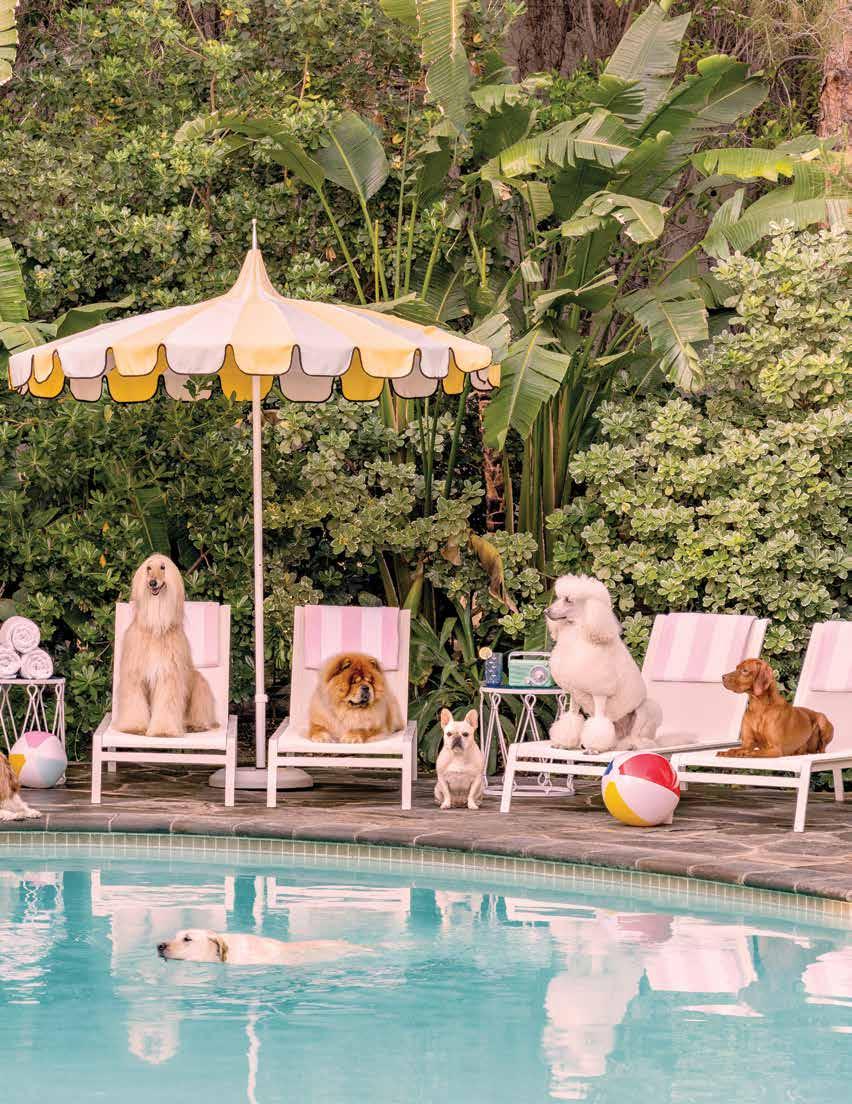
“There's a total escapism in my work, which is really part of it,” Malin says. “There are some real realities, but I like people to think it's real. There's fantasy involved.” To maintain that dream for the viewer, Malin works far in advance to plan and visualize how he will get the shot he wants. Otherwise, he says, “you're just petting dogs the whole time.” Admittedly, there are many moving parts when working with animals (each one comes with a trainer and an owner, divas that they are), and while Malin's finished product always looks effortless, working with even the most well-trained can't account for the models that just can't get along on set.
Cinematic, the color palettes of these works easily complement home interiors, and Malin has noticed his images hanging over the nurseries of children and above bar carts of adults. The shots are also showcased in his children's book Be Our Guest, which he published in 2018. But what the photographerauthor likes the most is taking in the reactions of the viewers themselves, who always have something to say.
"A lot of my work is very conversational," says Malin. "I think artwork should, you know, excite people and get them to talk. That is very important to me."
60

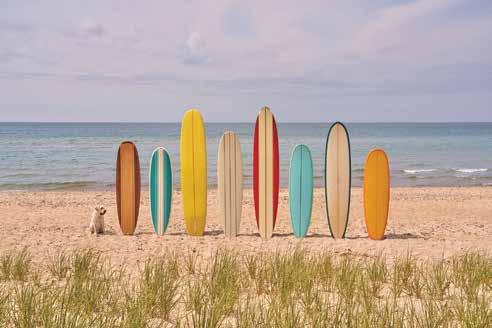
The big-wave surfer has made a career out of defying norms and challenging expectations.
All eyes were on Keala Kennelly from a young age. Not yet a pioneer of women’s big-wave surfing, a world champion, or an activist for LGBTQIA and women’s rights, she was merely a blonde and tomboyish 6-year-old eager to paddle out and score waves. Beside her on the Kaua‘i shore were her childhood friends Andy and Bruce Irons, Kamalei Alexander, and Reef McIntosh. She didn’t feel out of place. Keala looked, acted, and surfed like them—to her, she was one of the boys. But, as Keala remembers, some watchful adults saw her differences and shook their heads in disagreement. As a collective body, the groms hit the water and start paddling to the lineup, with Keala in the lead.
Keala Kennelly rode her first wave with her father when she was a toddler. As a kid, she and her friends, many of whom were boys, explored, played football, rode bikes, and surfed every chance they could get. But in 1984, when she was around 6 years old, she recalls adults beginning to dissuade her from participating in what they deemed “boy activities.” She became depressed at a young age, acutely aware of the privileges and freedoms afforded to men and the lack thereof for women.
In her adolescent years, an androgynous Keala was ostracized by both boys and girls. She struggled to understand her lesbian sexuality without any queer mentors for guidance. But she had a strong sense of identity. “Haters are my motivators,” she says. She turned to the only outlet she had: surfing. Her drive and innate talent on the waves naturally led to a competitive career.
In 1995, after a frustrating and lonely paddle out, Keala arrived at the crowded lineup. She was 17 years old, and it was her first year on
TEXT BY KYLIE YAMAUCHI IMAGES
BY CHRIS ROHRER
KEALA KENNELLY RIDES AGAINST THE CURRENT 62


64

the championship tour of the Association of Surfing Professionals. She looked around and was relieved to be surrounded by female faces. Yet these women weren’t like Keala with her muscled shoulders, cropped and spiky hair, defined jawline, and piercing gaze. They were stick thin and clad in skimpy bikinis—illustrative of the sexist pressures placed on female athletes by the industry.
When Keala entered the tour, queerness was considered a taboo that invalidated one’s talent. “My sexual orientation was immediately put into question,” Keala says. “I felt like I was living under a microscope of people trying to witch-hunt me.” To protect her career, Keala hastily revealed she was dating a man at the time. Regardless, a seven-page profile by Surfer Magazine, suggestively titled The Naked Truth, insinuated she was in a lesbian relationship. Without her consent, her sexuality was again publicized.
Despite Keala’s impressive rankings throughout the years, the ASP’s homophobic and sexist atmosphere left her disillusioned with the sport. The prize money for women’s contests was well below that of men’s contests. (In the 2006 Quiksilver-Roxy Pro Gold Coast, the firstplace men’s winner received a $30,000 check, while the first-place women’s winner received $10,000.) Women’s contests were carelessly held in poor surf conditions while the men’s were held in prime conditions. To female competitors, it was made clear that they were merely a sideshow.
In 2006, drained by years of pretending, Keala decided to stop hiding her sexuality.
She began bringing her girlfriend to contests and introducing her as such. All the cautionary tales Keala had heard quickly became true: After coming out, she soon received the news that three of her sponsors—Red Bull, Spy+ Eyewear, and Vestal Watches—would no longer support her; Billabong reduced her salary by half for the next five years. This marked her exit from the tour.
But, all was not bleak. The end of Keala’s career marked the beginning of her new life. “I think not living your truth and not being authentic to who you are is such a soul-crushing existence,” Keala says. “When I came out, I felt so free to be myself—so unapologetically myself, and once you feel that you can’t ever go back.” Keala could finally enjoy the freedom of surfing without limits. She sat in a lineup at Pe‘ahi (also known as Jaws) with a like-minded group of women surfers, all of whom had been left jaded by the inequity of the sport. Massive, rolling sets reached over 40 feet high at the Maui surf break. These were the waves that spiked her adrenaline and drew on her dark rage, the inner spirit that compelled her to perform her best. Keala began to set her sights on a new kind of prize, something more glorious than any trophy she could have won on tour.
At 38 years old, Keala found herself battling for equality in women’s surfing. In 2016, she and big-wave surfers Bianca Valenti, Paige Alms, and Andrea Moller, with the help of San Mateo County Harbor District commissioner Sabrina Brennan, formed the Committee for Equity of Women’s Surfing. They set their sights on
66

Mavericks, an iconic big-wave surf break notorious for being exclusively male during competitions. (The 1999 flyer advertising its first year labelled it for “Men Who Ride Mountains.”) A women’s heat at Mavericks, and the promise of equal prize money for men and women, would send shockwaves through the industry.
The committee immediately faced pushback. The Mavericks organizers would not yield, forcing Keala and the other activists to lobby California state officials. Throughout it all, the women received a flurry of hateful messages, many of which blamed them for ruining the contest for the men. When the committee asked other female surfers to stand in solidarity, many declined, the backlash scaring them into silence.
Despite the harassment, the committee succeeded. In 2016, a women’s division was added to the Mavericks contest, though unsurfable conditions led to its postponement. The following year saw a landmark event for women surfers. A sea change rippled through the industry. With the barrier-breaking success of Keala and the other activists came increased publicity for women’s conditions in the sport. In the span of two years, sentiments for change reached all the way to the top.
In 2018, Keala received a call from Sophie Goldschmidt, CEO of the World Surf League (formerly known as the ASP). She informed Keala that beginning that year, the WSL would begin awarding equal prize money for all contests—regardless of gender. The decision made surfing one of the only sports in the United States mandating pay equity.
For Keala, the win was cathartic. “When you’ve been fighting this battle your entire
life and then you actually get what you’ve been fighting for, it’s almost as if you can’t believe it’s happening,” Keala says. “I was in disbelief for a long time.”
Surrounded by a sisterhood of women surfers, Keala now feels unstoppable. Some people still watch her with contempt, but years of achievements have given her unbreakable confidence. At 42 years old, Keala has witnessed a few changes in her surfing—her board has increased in size, she wears a helmet and floatation vest, and she’s the 2018 WSL’s Women’s Big Wave champion.
But her attitude toward the sport is the same: Surfing has supported her all her life and she doesn’t intend to give it up so easily. These days, when surf conditions are huge, she signals to her tow-in partner on a Jet Ski that she’s ready, and he begins to pull her onto a forming wall of water. With alarming speed, she begins her descent alone down the face of a wave she wants all to herself.
68
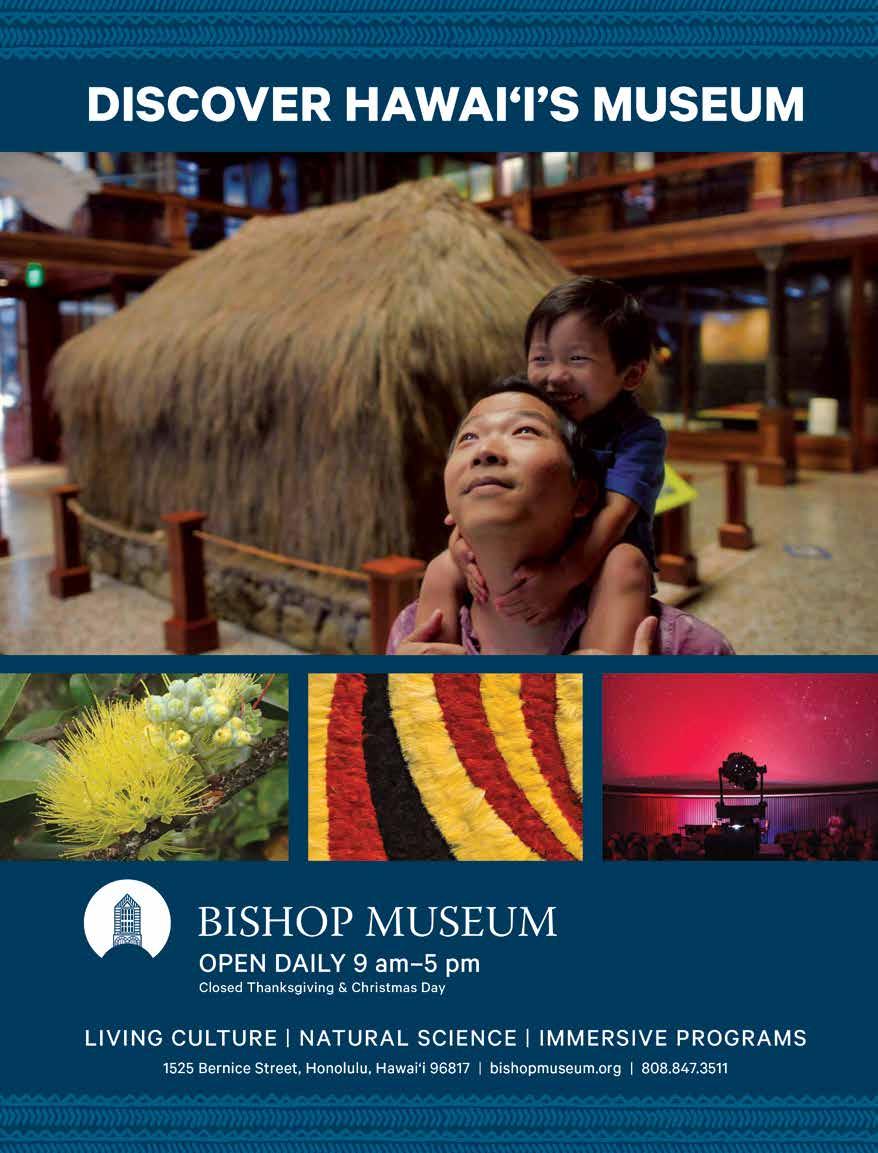
 TEXT BY EUNICA ESCALANTE
TEXT BY EUNICA ESCALANTE
70 STRONG LINES
IMAGES BY SAM MULLER
Kenneth Nicholson eschews
rigid notions of masculinity for a more romantic approach.
Kenneth Nicholson has a penchant for romanticizing life’s minutiae. Whether it’s the mismatched patterns of his grandmother’s living room, as referenced in his fall 2020 collection From Grandma’s Couch, or a simple bookmark (currently, a slip of silk earmarking his place in Ta-Nehisi Coates’s Between the World and Me), nothing escapes his rose-tinted Midas touch. So it’s no surprise that the Los Angelesbased fashion designer’s eponymous label is an amalgamation of life’s finer things: lace and velvet and silk and linen. His simple, elegant silhouettes drape the form and bestow an air of nonchalance.
Yet the 37-year-old’s designs are more than just pretty things to behold. Underlying his fondness for the refined is a striking intuition for the potential of menswear. Nicholson, with his talent for melding the traditional with the experimental, is part of the new guard shepherding the future of the industry.
Take his debut collection, Maritime Man. Its strong lines and military details were influenced by Nicholson’s four-year stint in the U.S. Navy upon graduating college, to which he credits much of his self-discipline. Despite this traditionally masculine inspiration, the collection’s billowy silhouettes and use of organic fabrics point to his burgeoning approach to menswear. Or consider his spring 2019 collection Lover from the Bath. Its opening ensemble of a full-length, linen tunic and tights brings to mind that iconic scene of Colin Firth emerging from the lake as Mr. Darcy. The rest of the collection is equally as romantic, the designs imbuing his male models, mostly people of color, with a certain softness society so rarely affords to Black men.


Nicholson has always had a designer’s eye. Growing up in Houston, he experimented with dressing differently than his peers, preferring thrift stores over fast fashion. By middle school, he was making his own clothes with a sewing machine his mother gifted him. His freshman year of high school, he designed a full-blown collection for the talent show. The lineup of 35 looks, an impressive feat for any designer but even more for a 14-year-old, helped the young Nicholson exercise his artistic sensibilities. Also, it allowed him to show a part of himself that others may not have had access to otherwise. “As an artist, you have these moments in life where you come to the fact that you don’t see the world as everybody else does, and sometimes your peers can ostracize you for that,” Nicholson says.
Inclusivity is the through line of Nicholson’s work, and he hopes that his approach to menswear ushers others into their own, unapologetic sense of self. Since debuting his label in 2016, Nicholson has quietly garnered a following. His designs have dressed the likes of actor Jaden Smith and musician Lil Nas X, both of whom embrace fluidity in gender expression. Early in 2020, the Council of Fashion Designers of America nominated Nicholson as the American Emerging Designer of the Year, an honor signaling Nicholson’s place among the vanguard of menswear.
Through his designs, he brushes off traditional notions of masculinity in favor of a more fluid approach. Far from the structured suits and streetwear-focused ensembles that have characterized men’s fashion, Nicholson’s work taps into the social metamorphosis of recent years, eschewing outdated gender identities for more fluid concepts of expression. And contrary to other luxury designers,
Nicholson is not cashing in on a “fashion has no gender” trend. Beyond dressing his models in more feminine designs, Nicholson attends to the nuances of the male form. Trousers and dress shirts, usually tailored snugly, are long and loose. Meanwhile, his proclivity for details like ruffled lace or pops of silk leave his models decorated like 17th century royalty. “I want people, regardless of how they identify, to be able to come into the Nicholson space and feel like there is something for them,” he says, “because that’s what I feel like my life is.”
Despite his growing success, Nicholson remains conscious of the industry’s tendency to stereotype Black designers. Though parts of Nicholson’s designs do draw from specific Black experiences, such as the Sunday church mood of From Grandma’s Couch, he is careful to note that the traditions he pulls inspiration from aren’t just the ones that society has stereotyped as Black.
“When I’m talking about Black tradition, I’m thinking about intellectual and artistic contributions—anything from jazz, rock, history, culinary, philosophical,” he says. “And for us to have created all of those things, even in the face of a country that extracts Black excellence and Black wealth for commodity? For us to have heavy-handedly contributed to society, and not only make it better but push it forward? That is the tradition out of which I’m working.”
74
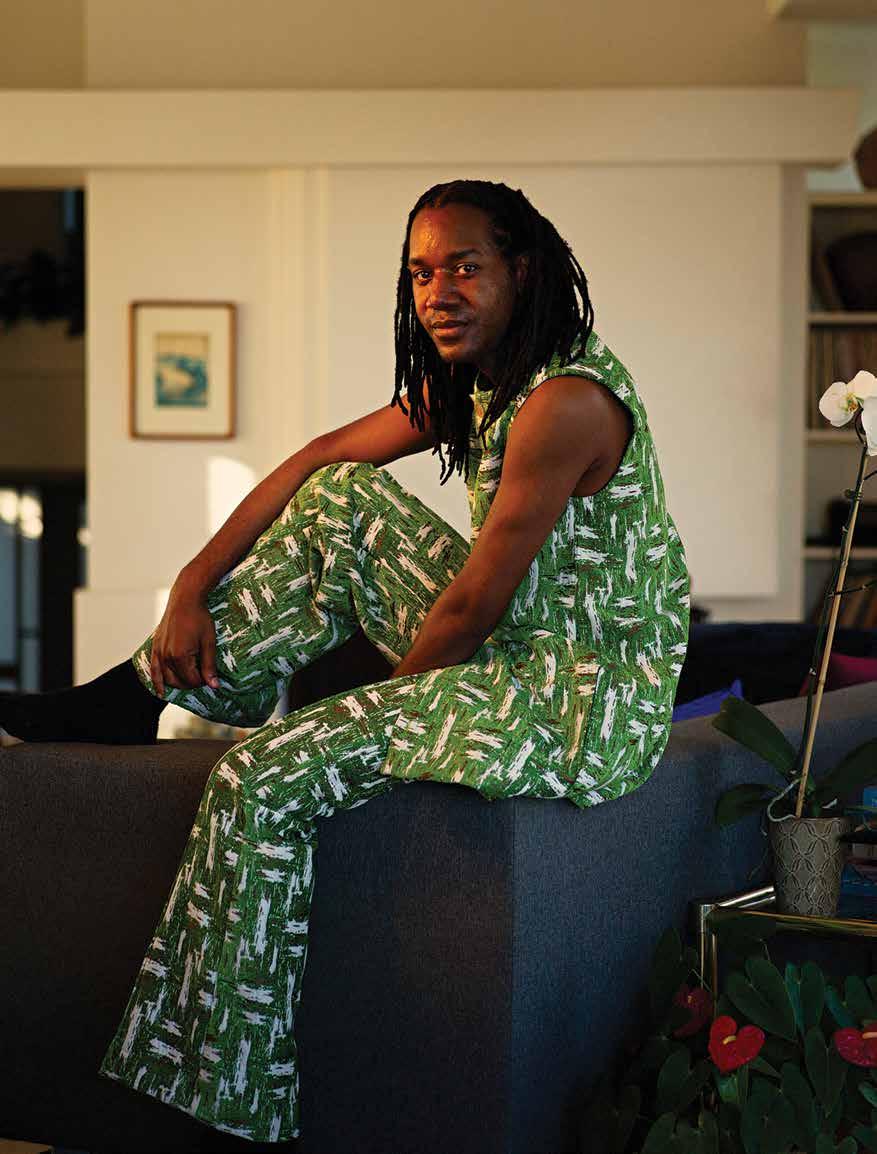
Hailing from opposite ends of the country, but united in their love for performance, spectacle, and each other, Alexander Propios and Issa Perez are a creative powerhouse couple.
In the heart of Brooklyn, one can find Alexander Propios and Issa Perez laughing, dancing, and sewing a 9-foot-long durag. Surrounding them is a sea of corsets, fishnets, and custom pleather bodysuits—all tailored to fit the, multidisciplinary, split-dropping, politically-charged, hip-hop performance duo The Dragon Sisters, the drag act comprised of Issa and fellow dance extraordinaire Cain Coleman. As The Dragon Sisters, Issa and Cain have been featured in the likes of Vogue and Billboard, and on the fierce stage at 3 Dollar Bill, the premier queer bar and performance venue. Often, they are outfitted and co-styled by Alexander.
Alexander and Issa, partners in love and life, are a creative powerhouse couple. A graduate of Honolulu Community College, Alexander trained under designers Ari South and Kini Zamora and has designed custom pieces for Hawai‘i’s top drag queens and pageant queens. Since moving to New York in early 2019, Alexander has pivoted to creating showstopping wares for The Dragon Sisters, while pursuing a bachelor’s degree in textile design at the Fashion Institute of Technology. Their work together has been a culmination of Issa’s classical training as a dancer and Alexander’s devotion to fashion design.
I’ve spent many days and nights with Alexander and Issa in New York City—from kikis on Manhattan rooftops to shooting for hours on end at Egg Studios in Bushwick. Recently, I had a chance to catch up with Alexander and Issa in Honolulu, where Alexander and I were both born and raised. We reminisced and talked story about the couple’s serendipitous meeting, the impact of
76
TO COAST
INTERVIEW AND IMAGES BY MAHINA CHOY-ELLIS
COAST

Hawai‘i and New York City on their artistry, and their hopes for the future.
First things first: What are your pronouns?
Alex: He/him.
Issa: All of them! Just as long and they’re used with respect.
Alex, I met you in Hawai‘i in 2016. What influenced your decision to move to NYC and how has New York impacted your work?
Alex: Ever since I was young, I was always drawn to the city. When I was in college at HCC, I knew that it was the best place for me. It was on my first trip to the Garment District in Manhattan that every fabric, trimming, everything is at your fingertips. The range of costumes, the gay culture, and streetwear in Manhattan and the queer scene in Brooklyn is just so exciting. The vibe is just unmatched.
Issa: I was born and raised in New York. New Yorkers are so community based—it’s a tough city to live in. People take care of each other. It’s this upbringing that raised me to be efficient. The best drag queens come to New York. If you want to be somebody and go somewhere, you have to keep up. And I love it.
Second most important thing: How did you two meet?
Alex: It was a Covid love story! I was coming back from Oregon visiting my
family. I was actually ready to move back to Oregon. I literally landed. I opened my Grindr. And there he was and we had our first date the next day. The rest was history.
How soon after you two met did you start working together creatively?
Alex: It was our first date! Rupaul’s Drag Race came up and I was like, “I love drag! I have so many drag queen friends!” Issa showed me photos of her in full drag, doing a full extension in Times Square, and I was in love! It was after our first date that we were magnetized to each other.
Issa: It all started with the first piece: a pair of 6-foot-long durags. It took a while but we had so much fun. It was after that one night working together that we knew we could work together. And we’ve just never stopped. I say that I’m a professional improvisor and Alex is a professional planner, so we balance each other out so well. We always keep each other accountable. We encourage and support each other always.
Alex, when did you first start designing?
Alex: As a kid. I always loved to imitate my dad and grandpa, who were both artists. From houses to trucks to all kinds of people from chopping off hair to put onto drawings. In 2012, I saw Ari South on Project Runway which led me to go to HCC. Ari was such a huge inspiration. My freshman year at HCC I did an internship with her.
78



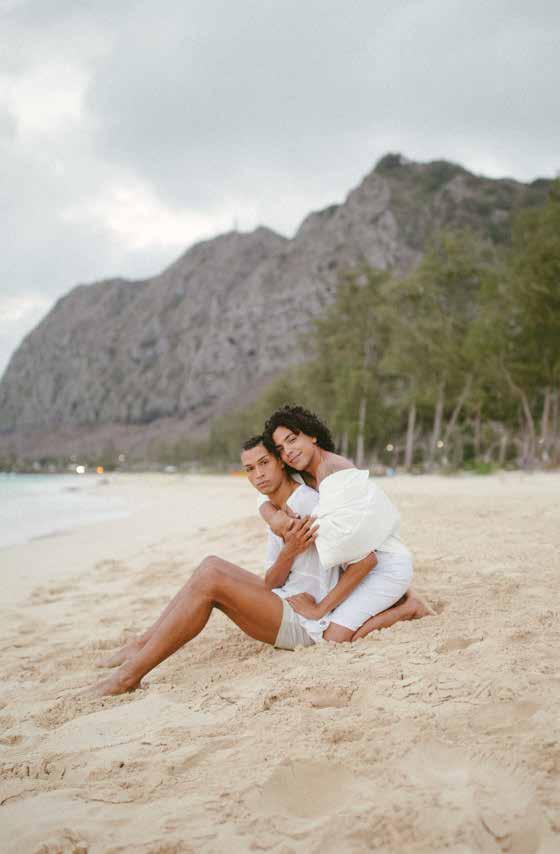
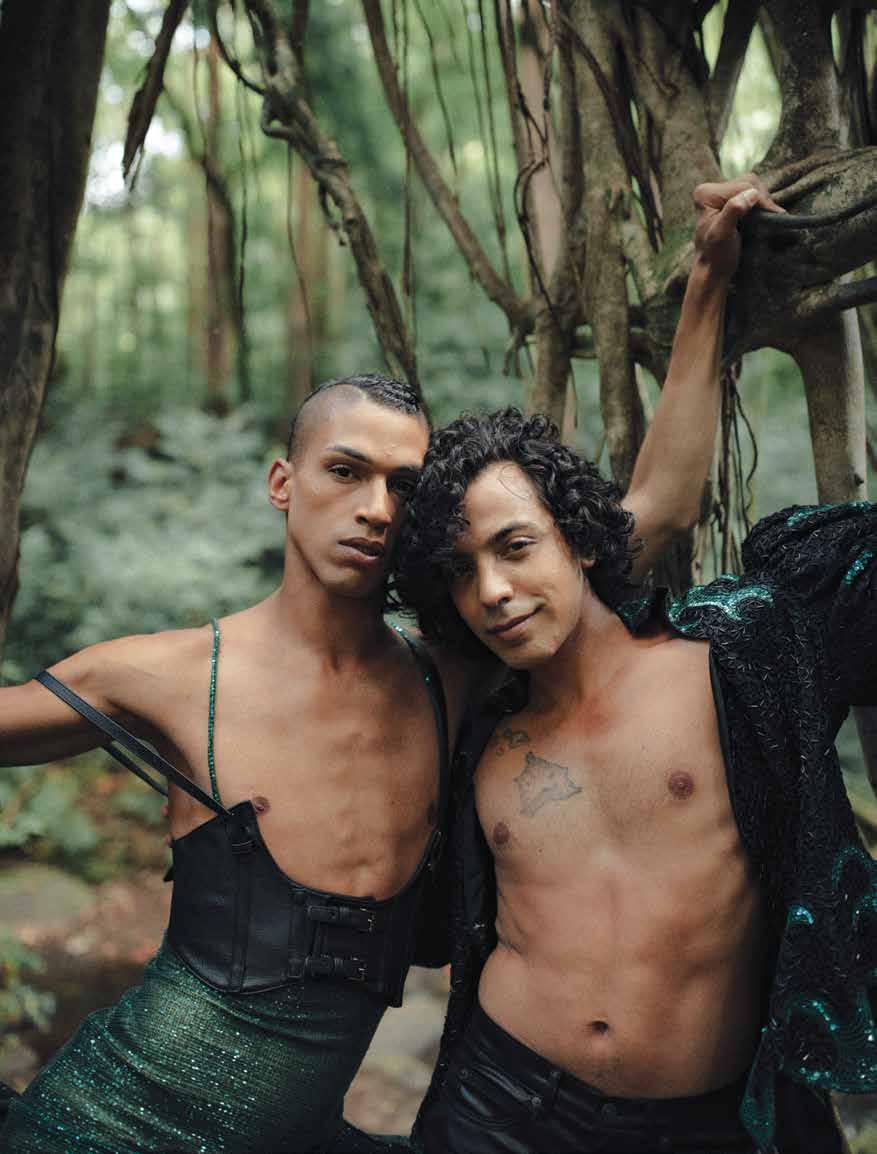
Issa, when did you start performing?
Issa: I performed during family parties and school talent shows, and I took it very seriously. It wasn’t until I joined Drama Club that I considered performing professionally. In my family that’s not a likely career choice. I started doing drag in 2018. Over the years, I was doing it all in parts: classical art forms, classical dance, my experience as a Latinx Black New Yorker. My Dragon Sister, Cain Coleman, also put in all the hard work through dance. We met at the North Carolina School of the Arts. All of our efforts have accumulated up to this point: to becoming The Dragon Sisters.
That’s a great point, Issa. What does your family think of your respective career choices?
Alex: Both sides of my family are so supportive! They’ve seen me excel in design and art since I was a child. There was no concept of the “starving artist.” Before my father passed when I was 17, he helped me write my letters to the Art Institute of San Francisco. I always showed my family all the costumes I made for dancers at Scarlet and such and they just gagged.
Issa: My family was so supportive because they see that performing is where my heart is and where they saw me excel. I first fell in love with musical theatre, so I went to the University of North Carolina School of the Arts, a very selective performing arts conservatory for acting. There are
only about 20 students that get selected for your senior year. I felt muted in a way because I was still in the closet. I would get made fun of in fear of saying something that’s “too gay.” I think this stifled my ability to really express myself fully.
Thank you for sharing that with me. Speaking of, how has the queer community influenced your designs and your inspiration as a performer?
Alex: I came out right after my dad passed when I was 17 years old. That changed the trajectory of my entire life. When I came out, this whole world opened up to me: drag, Scarlet, working with Kini Zamora, of course. Being able to work for Kini Zamora and being surrounded by people like me, it was empowering. It was the definition of freedom not only personally but creatively. Learning from Zamora helped me design for so many drag queens in Hawai‘i and later New York. It was actually through Covid—when all drag shows were cancelled—that I realized the gravity and how beautiful and important the drag and the queer community—my people!—have impacted my whole life.
Issa: It was when I started drag that I really did see how the queer community not only influences me, but how I could contribute as well. Before I started drag I always had a superficial idea of what drag was, until I was more educated and dove deeper. Quarantine gave me and Cain the gift of time to really develop and invest our time
and creativity into who The Dragon Sisters are today.
What is your creative process together?
Alex: My background is in custom and dramatic bridal pieces. I was always surrounded by volume, sequins, and drag all within a beautiful Hawaiian context. So I come to New York and I meet Issa and Cain and they’re so creative! Our friend, Braden Clark, born and raised in Hawai‘i, helped design The Dragon Sisters’ beautiful cover art. We are so grateful to be able to collaborate with friends.
Issa: Our creative process is a gorgeous collaborative tornado! It feels so good to have support creatively and we can all bounce off of each other all the time. I am super inspired by Alex’s concept of color, proportions, and depth.
Alex: What makes it perfect is both of us growing separately before we met each other. Our relationship is a combination of culminating to this place where we can take our skills and past experiences and put them together. It’s just so awesome to see Issa grow on his own too. It’s so beautiful and I’m so proud.
What do you see for yourselves in the future?
Issa: We’re going to be on tour. Gettin’ money.
Alex: More extravagance. Bigger stages. Collaborating and creating a team for us to just up the ante!
Issa: A year ago, I could have never known where we would be today. The only thing I knew for sure was I was very in love with Alex. I could never have guessed what this journey would hold.
What words of advice to you have for any young, queer, and/or BIPOC creatives?
Issa: You’re never going to “make it.” Because it’s 100 percent about the journey. No matter what level you’re at, you’re always going to be working. Know your purpose. Zoom out, look at the bigger picture, and see where your strength lies and be honest with yourself.
Alex: As far as coming out, I felt like I was in a dark room and then a light just came on. I hope you have the courage to be yourself and sit in your power. It’s a beautiful thing. For the young creatives, it doesn’t matter how many covers you’ve been on or how many gorgeous dresses you’ve made—there’s always more to learn. And lastly, like what Oprah said, a good indication of what you want to do is what you don’t want to do. And use that to point you in the right direction of where your passion is!
This interview has been edited for length and clarity.
84


III. Explore
Connect with locals who see their cities as maps to self-discovery
VIVA LAS VEGAS
Why the roaring '20s mean it's time for the LGBTQ traveler to go back to Sin City.
Las Vegas is a city of transience and transformation. It relies on the new, the now and the next as a way to lure tourists, its biggest moneymaker, and keep them captivated and coming back for more. After a lengthy hiatus caused by the pandemic, Sin City is placing some big bets on new and updated hotels, thrilling attractions and tastefully stimulating experiences that have heralded what many call another roaring ‘20s.
With new residencies and restaurants from Adele, Katy Perry, Martha Stewart and Lisa Vanderpump to the debut of Formula One and potentially groundbreaking planet-shaped theater rising up, over-the-top showmanship is returning to Las Vegas in a big way, and competition is heating up to entertain visitors on a level that hasn’t been seen in years, which should give everyone a good reason to consider booking a trip to the desert.
It’s for that reason that Lei has chosen Las Vegas as one of our favorite destinations for LGBTQ travelers to visit over the next year, and one worth putting high on your must-visit list in the near future.
If you didn't think the world revolves around Vegas ...
Nothing exemplifies the future of Las Vegas’ commitment to ambitious audaciousness than Madison Square Garden Entertainment’s Sphere, a $1.8 billion live entertainment venue that is designed to transport spectators to different environments with high-tech LED screens that wrap around them and the performers.
Once complete, it will be the largest spherical structure in the world
TEXT BY MARC GRASER
IMAGES BY JOHN SHEARER COURTESY OF MSG ENTERTAINMENT, MAGIC MIKE LIVE!, SPIEGELWORLD
Katy Perry performs at Resorts World as one of Las Vegas’ newest musical acts. On the following pages: The MSG Sphere, a first-of-its-kind live performance venue will use high-tech screens. Magic Mike Live! at the Sahara, and Spiegelworld’s Wild West-themed Atomic Saloon show, at The Venetian resort, are two LGBTQ-friendly shows that aren’t afraid to show off some skin with impressive acrobatics.
88


with over 580,000 square feet of exterior screens that will illuminate the night sky. One in London is also planned, and given how its exteriors are expected to be programmed, the Sphere could become the next version of the Ferris wheel so many destinations have erected as iconic eyecatching attractions.
The first theater, right behind the Strip’s Venetian resort, is a big bet given that performers still need to figure out how to take full effect of its massive displays. And with a capacity of 20,000 guests and 23 VIP suites, it has a lot of seats to fill and concessions to sell.
But given that MSG owns New York’s Madison Square Garden, Radio City Music Hall and popular day and night clubs like Tao, Hakkasan, Marquee and Omnia, it’s either come up with an industry changing way to entertain audiences or one of Las Vegas’ biggest flops.
“We hope we’ll redefine what it means to do live entertainment,” MSG Entertainment’s Lucas Watson has said. “It certainly has the potential to be one of the most photographed buildings on the planet.”
What's old is new again.
While the Sphere will be a bright new addition, a number of other major developments have already started to transform the Las Vegas skyline.
Resorts World Las Vegas, which debuted in 2021, was the first major resort to open on the Strip since The Cosmopolitan of Las Vegas in 2010. The $4.3 billion behemoth, which replaced the iconic Stardust, hosts three hotels (a Hilton,
Conrad and Crockfords), casinos, upscale pool, Zouk nightclub, AYU dayclub and concert venues.
Fewer visitors during the pandemic gave casinos the time to spend considerable coin to give their hotels and overall properties facelifts, including Caesars Palace, the Nobu Hotel, Bellagio and Circus Circus. The Wynn spent $200 million to update its 2,674 rooms to make them warmer, more relaxing and hightech at the luxury resort — it hadn’t been refreshed in 17 years.
With the Palms Casino Resort now owned by the San Manuel Gaming and Hospitality Authority, making it the first tribal owned and operated casino in Las Vegas, the resort received a top-to-bottom $690 million update. That includes its popular Ghost Bar, a rooftop hangout with some of the best views of the Strip.
It’s understandable if things are getting a little confusing when it comes to Las Vegas hotels. The Hard Rock Hotel is now a Virgin Hotel, refreshed with its cheeky attitude. The Hard Rock is taking over the Mirage and plans a new guitar-shaped tower of rooms, replacing the erupting volcano. Bally’s is becoming the Horseshoe to appeal more to gamblers, while the Tropicana may soon become Bally’s.
Another exciting luxury development is the Fountainbleu, a sister resort of the original Fontainebleau Miami Beach hotel, at the north end of the Strip. Long delayed, the 67-story hotel and casino will open in 2023, across from the Las Vegas Convention Center.
Finally, expect some updates to be made to the posh Cosmopolitan now
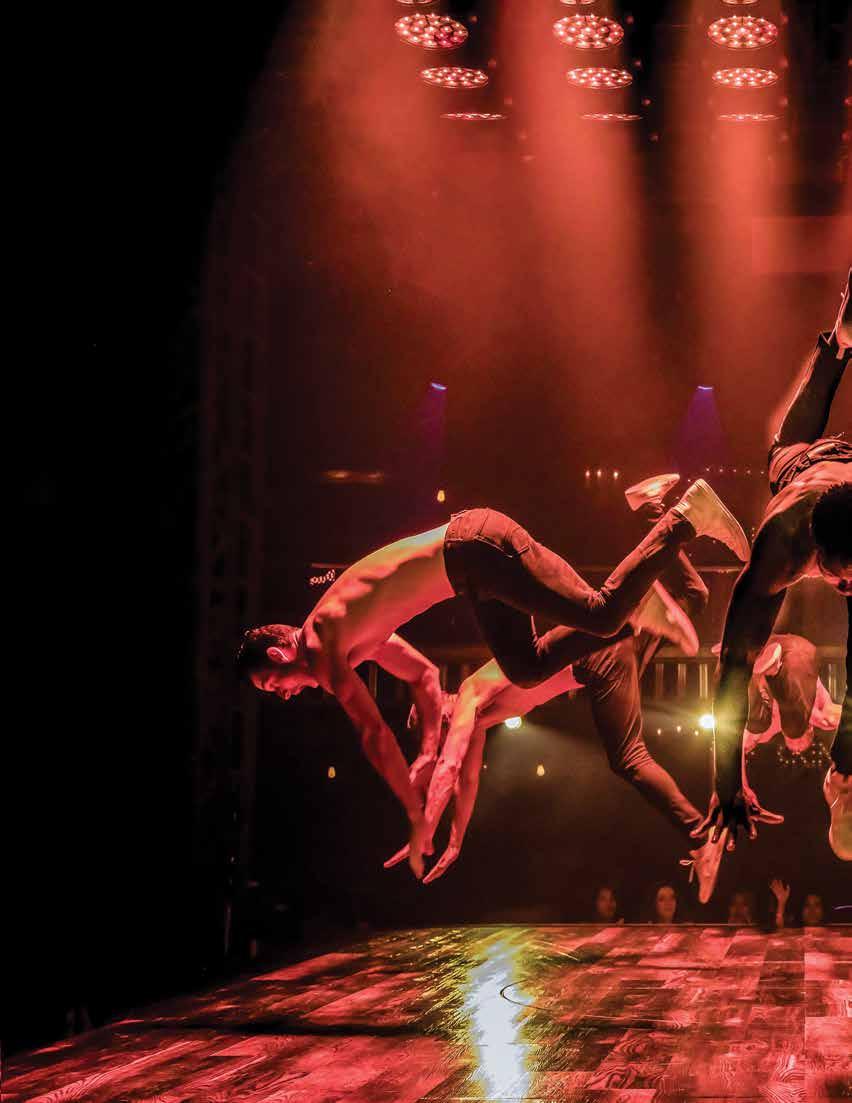


that MGM has bought it for $4 billion. Its Marquee club is a massive draw, as is the hotel’s three-story crystal chandelier and Vesper martini bars, which have recently updated their menus with new cocktails.
Where sex always sells.
Along with new restaurants from Todd English, Michael Mina, Bobby Flay and a third Nobu in the city from Nobu Matsuhisa, Martha Stewart is making her official debut in Las Vegas with farm-to-table restaurant The Bedford, inspired by her country farmhouse in New York.
Meanwhile, The Real Housewives of Beverly Hills and Vanderpump Rules star Lisa Vanderpump has opened Vanderpump Cocktail Garden at Caesars Palace, and Vanderpump à Paris restaurant inside the Paris Las Vegas casino, with designs heavy on her signature glam.
The Voice’s Blake Shelton will open Ole Red, a $30 million three-story bar, restaurant and live music venue at the new Horseshoe, in 2023, with a view of the Bellagio fountains.
After having to close his Los Angeles, London and Tokyo outposts, it’s nice to see cronut-creator Dominique Ansel opening his first restaurant at Caesars, with his bestselling kouign amann pastry, Cookie Shot and Frozen S’mores on the menu, which can be found at his SoHo location in New York City.
Las Vegas certainly lured the LGBTQ traveler when Britney Spears set up a residency at Planet Hollywood in 2013, following Celine Dion’s sensational run at
Caesars starting in 2003. Now Caesars has given Adele its biggest stage with a show that’s being creatively reworked.
Over at the new Resorts World, Katy Perry is headlining, while short and long term residencies at venues up and down the Strip feature John Legend, Luke Bryan, Usher, Miranda Lambert and dancer Derek Hough.
While Cirque du Soleil shows and old school hits like Australia’s Thunder from Down Under have long titilated the queer community, Las Vegas has stepped up its gay friendly offerings, with new shows up and down the Strip that tout being “unapologetically raunchy,” “outrageously amoral,” and only for audiences 18 and above.
There’s a lot of titillation at Channing Tatum’s Magic Mike Live!, that’s based on his stripper film franchise. A Vegas show seems like a no-brainer, and it’s a production that’s surprisingly elevated and well choreographed at the Sahara resort.
Equally winning are shows like the circus-themed Absinthe, at Caesars Palace, and Atomic Saloon, a wild west romp at The Venetian, where a mix of beautifully chiseled male and female bodies perform acrobatics in highly stylized Vegas environments. Fantasy, at the Luxor, is essentially an allfemale version of Magic Mike Live!
Yet the biggest draw is clearly RuPaul’s Drag Race Live!, based on the wildly successful TV show. It features fierce costumes and production numbers starring a rotating cast of new and previous contestants taking the stage at the Flamingo resort. The show’s stars are in such high demand you’ll find them
stopping by Treasure Island’s Drag Brunch and Faabulous! The Show & Drag Brunch at Neonopolis on Fremont Street.
There’s always been something queer about all of Las Vegas, and while the city’s gay bars are still going strong in the Fruit Loop, east of the Strip near the new Virgin resort, all of the city’s casinos know that being inclusive and catering to an LGBTQ traveler has never been more important beyond its Pride Festival in October.
It’s why you see RuPaul getting the main stage at the Flamingo; the Luxor actively promoting Temptation Sundays, Las Vegas’ only LGBTQ pool party; and the city’s High Roller Ferris wheel courting same-sex couple with wedding packages. It’s also why Adele, Martha Stewart and Katy Perry, all with strong LGBTQ fanbases are being announced.
Events like the annual Electric Daisy Carnival pack the city, and if you’re a DJ with any notoriety, you’ve got a bright future in Vegas. That’s been the case for awhile — Paul Oakenfold, Zedd, Steve Aoki, Diplo, Tiesto, The Chainsmokers Martin Garrix and Kygo are among the top headliners luring dance music diehards. Yet with exciting new night and day clubs opening at new and refreshed hotels and casinos, the demand for talent has never been higher. New immersive experiences like the neon playground of Area 15 are also hosting more notable acts and provide creative new environments that signal where Las Vegas is headed when it comes to entertainment options.
Those options include sports. Beyond betting and UFC matches, Las Vegas wasn’t
much of a sports town. But that’s changed considerably in recent years. An expensive new stadium and arena for its Raiders football and Golden Knights hockey teams attract sell out crowds per game on or near the Strip, boosting business for hotels, restaurants and bars at the same time. The teams’ successes have now encouraged the NBA, MLB and MLS to consider moving teams to the city or expanding with new basketball, baseball and soccer franchises.
What will only help bolster the city’s sports image will come in 2023, when it hosts its inaugural Las Vegas Grand Prix, which will have Formula One race cars scream down and around the Strip.
Las Vegas will always embrace brash and bold when it comes to its future. It needs to in order to keep its hotels full and money flowing into its casinos. That’s no easy feat given the size of these properties.
Note that Caesars Palace, alone, has more than 3,500 hotel rooms in five towers, 10 bars and lounges, 22 restaurants, seven pools and then shops inside its Forum mall.
“It’s gotten really competitive with every hotel now having its own theater to fill,” says the head of marketing for one new major property. “I’ve never seen it like this.”
96


98 LIVE & LOUD IN
TEXT BY EVAN ROSS KATZ IMAGES BY XAVIER LUGGAGE
LAS VEGAS
Stars of RuPaul's Drag Race
LIVE!, Latrice Royale and Jasmine Kennedie are turning Sin City drag upside down and inside out.
Since its debut in 2009, RuPaul’s Drag Race has spawned an impressive and exhaustive 180 contestants—and that’s just the American version. The hit program has earned the Primetime Emmy Award for Outstanding Reality-Competition for the last four years in a row (amongst its 20 other wins), is on the The Guardian's list of the 100 best TV shows of the 21st Century, and has franchised globally with spin-offs in Thailand, UK, Canada, Holland, Australia, Spain, Italy, the Philippines, France, Sweden, and Belgium with more in the works.
And though conventions have popped up in Los Angeles, New York, and the UK that allow fans to get up close and personal with their seasonal favorites, few opportunities have existed to see an entire roster of queens performing original material live.
Enter the elite queens of RuPaul's Drag Race LIVE!, who dazzle in a scripted and stylized version of the reality competition series, which includes original music, lip syncs, comedy, and dance numbers every Thursday through Monday at the Flamingo Las Vegas Hotel & Casino.
With nearly 240 anti-LGBTQ bills filed in 2022 alone, the world could use a heavy pour of queer joy. And who better to give Vegas the necessary queer showgirl eleganza than the original stars of the show? Directed by RuPaul with Drag Race resident choreographer Jamal Sims, the musical extravaganza first premiered in January 2020 but was paused due to the pandemic.
Two years later, the show is back and better than ever and features two new additions: the “large
and in charge, chunky, yet funky” (her words) Latrice Royale and the sickeningly entertaining, never tongue tied but always tongue twisted Jasmine Kennedie.
The duo represent one of the live show’s best attributes: the fusion of the old-school grittiness of early Drag Race with its glossier, more highly-produced current era. It also comes at a time when Vegas could not be hotter.
Having first competed in the show’s fourth season in January 2012, Royale appeared in two seasons of its All Stars format in October 2012 and August 2018, while Kennedie is a recent addition to the pantheon, having appeared on the latest season of the franchise in 2022. Together with a rotating cast of other alumni, they comprise Vegas’s gayest nightlife experience.
“It’s like an episode of Drag Race on and off the stage 24/7,” says Kennedie, who says that despite the ubiquity of drag in Sin City there is no show like it on the strip. “It just spews gay!” she exclaims. Royale agrees with her signature bass bellow that invites you to fall in love with her immediately (which you do, you simply can’t not). “It don’t get any gayer than this, I mean, for real. RuPaul’s Drag Race LIVE! is the gayest thing about Vegas right now, and I love it! I loooooooove it.” She cracks up at her own declaration.
Royale, a Compton, California native, used to come to the city often during her teenage years to see the Kenny Kerr burlesque show. “That was my first experience seeing drag on such a huge platform,” she says. “So I knew things were possible. But never in my wildest dreams did I imagine that Drag Race Live! would be the headlining show on the Vegas strip.”
Another surprise for Royale: the show’s audience, which differs from the spectators she typically sees on the road, who may not have the expectations for the city’s historically high-quality drag. Vegas is, after all, the entertainment capital of the world.
“People here are hungry and they want to be entertained. That’s what they came here for; they love the show, they love the excitement, they love the fantasy, they love the feathers, they love the lights. It’s very specific, you make a conscious choice to come to Vegas for this experience, so they’re excited and eager and appreciative of all the work.”
Las Vegas was not what Kennedie, who was raised in Binghamton, New York, was expecting, either. “Having lived on the East coast the entirety of my life, when I first got here I was surprised at how much of a big city it felt like while still being able to get anywhere in 10 minutes.
She pauses, then in signature-Kennedie exuberance: “I love it!” Like her sister, she is energized by the crowds’ adrenaline each night. “It’s been a very meaningful and warming feeling,” she says, having spent a large part of the pandemic, like most performers, away from the stage. “You can sense the energy in the crowd. They are so happy to be back out and to see queens performing again. I've never had this consistency in a crowd before. It's amazing!”
Another unique aspect of the show is its production value, which fuses the queens’ talents with Vegas’ signature “bigger is better” appeal. And this opportunity is something neither of its stars takes for granted.
“Being a part of this franchise is not only an honor, it’s a privilege,” Royale says.
100





“Sometimes people lose touch with their fans. [Drag Race LIVE!] gives my fanbase the opportunity to see me beyond a nightclub or standard theater. This is a fully realized production with working parts and a crew. It’s the behind the scenes moments that really make the show happen, and it’s just so amazing to see and experience and be a part of—that’s the difference and that’s what I love most.” Kennedie too is touched by the sisterhood formed by working with such a tight knit cast and crew each night: “They are all so sweet and supportive and we all want what is best for each other.”
Above all, both queens stress the value of being able to perform again after years of canceled shows and appearances. “It breathes life back into my body and my career and my motivation,” says Royale, her voice beginning to crack with emotion. “It’s what I feed off of. I didn’t know how bad I was starving for that human interaction and that exchange of energy and being able to take my audiences on a journey. That can’t be felt through a screen. You have to be there to feel this energy. Performing on its own radiates some, but not as much as it does when it’s live. Now that I’m in this position where I can actually have an exchange of energy, it has rejuvenated me in ways that I did not know I needed.”
It’s also brought their families out. Royale’s husband Chris came to see the
show recently, as did Kennedie’s father. “He was here for a week and came to every show that week,” says the latter. “It's funny, the last show he saw in Vegas was in 1987 at the Flamingo, and now his daughter performs there five nights a week. It’s a very meaningful and symbolic thing that I hold very near and dear to my heart.”
So what do the pair do when they’re not performing on the strip? “Hitting up dispensaries, chilling outside with my cats on the balcony, and enjoying the Vegas weather,” reveals Kennedie, who can typically be found poolside on her days off. Meanwhile, Royale is on a mission to discover the other fabulous elements of the city.
“Vegas has the best food ever!” she says. “I mean, really, really, it does. I enjoy finding the restaurants that I’ve seen on TV that come highly regarded. And I wanna see some shows! I wanna see some shows, I wanna support the other artists in this town.”
106

Couples dream of seeing the world with their significant other. For one budding love story, they had no choice.
This is a story of what happens when we say yes. Yes to life, yes to travel, and by the time these words are printed, yes to a lifetime of love.
The night we met I wore a white bathrobe and brown tennis shoes. My street clothes lay dripping on a drying rack from dancing in the Balinese heat just hours before. So all hopes of a cool first impression were obliterated from the beginning. Lucky for me, he wasn’t my height, my type, or even from my country, so I took solace in the fact that I would probably never see this very tall, extremely handsome and foreign man ever again because he lived in London.
That week, my friends and I were visiting Bali all the way from Los Angeles. I was single but had no real intention of leaving the group I arrived with (especially not for a boy I just met).
But over some vegan food, and with all my best friends present, the table talk meandered through the benefits of butt tanning to how much palo santo is enough to properly cleanse the days vibes.
And to my surprise, my tribe of wild friends didn’t scare him right out the door; he even agreed to come spend time with me on the beaches of Canggu a couple cities over.
Yes, it was as romantic as it sounds, and no he did not turn out to be a serial killer. We went dancing, watched the sunset, and laughed on mopeds in the pouring rain. I wrote him poetry, and he told me about how he loved reptiles and what life was like growing up in Poland. We spent every minute as if it were our last, because as far as we knew, it was.
TEXT AND IMAGES BY DAKOTA ADAN
108 FINDING LOVE IN BALI


But that single day turned into a weeklong romance spanning the entirety of the island and I cried when I finally watched his car drive down a dirt road to take him to the airport.
Maybe that’s how most holiday romances end, but for us this chance meeting in Indonesia turned into intentional visits to LA and London; with each visit as romantic as the last.
A couple months after Bali I brought him roses from the London Heathrow Airport, and we ate Indian food in some of the best spots in the UK. We laughed like bandits on the tube through the city and watched the day become night while sitting on Tower Bridge. In America, we took road trips to the Grand Canyon and he rolled in the waves of La Jolla cove with the wild sea lions that also frequent those waters.
However, each time we said goodbye I told myself, “Well this is it. It’s been fun. Thank you for the experience but I live in Los Angeles and two cities over already seems far. Never mind eight time zones and the Atlantic. I will probably never see you again, but if I am lucky I will have a new friend to visit when I happen to cross the pond.”
Perhaps that’s what made each meeting so sweet. Every moment shared was treated with the tender and sacred care of two paramours who knew this could be our last moment together. Sure we were in love. But we were realists living in different countries.
Right about the time I was getting comfortable with the commute (the direct flights from LAX to LHR proved easy enough) the entire world underwent a different shift that no one could have
predicted or planned for; the pandemic. Suddenly every single one of those 5,440 miles became a roadblock to our relationship (that’s 8,750 Kilometers for anyone not in the US).
To make matters worse, international borders closed down between the UK and the US. Without any warning, life forced our summer love into winter.
Two weeks of “flattening the curve” dragged on into 13 painful months of separation. We got creative. We had video chat dates where we would surprise each other with food delivered to our respective locations.
Movie nights on streaming platforms, touch bracelets for when a text couldn’t say enough, and I even received a few handwritten love letters during that time (ladies and gents don’t ever let people tell you distance is impossible).
In full disclosure, and despite our best efforts we did take a brief three-month break during that time. But the heart never forgets the people or places that foster its full bloom.
Perhaps it’s the passionate optimist in me, but I have always believed that a closed door is just a chance to open the windows. And after our brief break, that’s exactly what we did. If the borders would not open to us, we would find each other in whatever countries would let us visit. At one point, my partner even offered to swim.
Most couples dream of the opportunity to see the world with their significant other. I personally remember a work trip to Paris where my exact thoughts were; “the only thing that would make this moment more magical is someone to share it with.”
But for our budding love story, we



had no other choice. So every couple months we would save up our coins for a trip, run the numbers through every flight aggregator we could find, and every couple of months we would meet somewhere warm. Summer was back.
For me, travel wasn’t just a fun thing to do if you had the disposable income and the necessary days off; travel meant I got to see him. More than being trapped in the monotony of my house, travel felt like truly being home.
That year, we traveled more than anyone I knew. We frequented Mexico’s Caribbean coast and spent a romantic two weeks in Greece.
On the final morning in Mykonos, we watched the sunrise as we walked on the beach. I packed my bag while he stood on the balcony and waited for the world to wake up. But when he turned around his eyes were so full of tears, I don’t know if he actually saw the grief written all over me. “Every time I am with you it feels like I am living my real life,” he said, “the rest is just a waiting game for you.”
So how much of our day-to-day existence is spent on this waiting game? How many seasons pass us while we wait for life to change?
I asked myself that question dozens of times in the early days of our relationship. What if this is my shot? What if this trip is the one I will tell my grandchildren about one day? Or what if I am just addicted to the thrill of a romance unfolding on the other side of the world?
They say, the number one predictor of relationships is proximity, and yet there we
were in the middle of a global shutdown; and three years later, here we are. So as I open up my passport, and look at each and every stamp, I no longer see dates or shapes in colored ink.
I see stories, and adventures; chances taken and sweet versions of myself that were irrevocably changed by a destination and the people I met along the way. I see pieces of my heart left behind in far off places, and lessons given back to me that somehow left me feeling more alive than when I left.
For most of my life I never had a great answer for why I spent so much time, energy and resources on travel.
But if only to meet him… the light of my life, my personal Polish miracle… Well I suppose there is no greater purpose than this.
Editor’s Note: This story has a very happy ending. After falling in love in Bali, and spending three years courting in different countries, Dakota and Dariusz got engaged in Holbox, Mexico, in 2021, and were married in Las Vegas in 2022.
Osaka is Tokyo’s hipper cousin, a central hub in the country that knows how to have a little more fun, and is a lot more welcoming to the LGBTQ traveler.
 TEXT BY MARC GRASER
IMAGES BY SIHASAK PRACHUM, OSAKA CONVENTION AND TOURISM BUREAU, UNIVERSAL STUDIOS JAPAN, WILLIAM VACCARO
TEXT BY MARC GRASER
IMAGES BY SIHASAK PRACHUM, OSAKA CONVENTION AND TOURISM BUREAU, UNIVERSAL STUDIOS JAPAN, WILLIAM VACCARO
116
JAPAN'S CAPITAL OF COOL
If you’re visiting Japan for the first time, head straight to Tokyo. If you have some extra time, and want a truly local experience, get on a bullet train and hurtle yourself past Mount Fuji to Osaka.
Once you arrive, you’ll instantly notice it: a relaxed calmness. Not that uncomfortable, I’m in the middle of nowhere kind of feeling, but after exploring the modern metropolis that is Tokyo, with its constant hustle and serious focus on perfection, shoulders are lower in Osaka. Smiles have formed. You hear more laughter and chatter on the street. You even see a bit more color.
That’s because Osaka is that cool, more loose and laid-back cousin who’s excited to see you and wants to have a little more fun. Osaka is to Tokyo what Melbourne is to Sydney; Bordeaux to Paris; San Diego to Los Angeles — less conservative, uptight and ready to please because they’re also college towns where fun hasn’t been pushed aside for career just yet.
Here, you won’t see miles of black suit-wearing locals marching silently to work every day; you’ll likely find them in more fashionable hoodies and t-shirts because they’re off to class.
Osaka is easily one of the most underappreciated cities for foreign travelers in Japan, because Tokyo and its more historic templefilled Kyoto are typically higher on the list.
But Osaka shouldn’t be ignored. From exceptional bars and restaurants to attractions, hotels, convenient airports and central location, this is a city that will provide any visitor with the kind of memorable Japanese experience they seek no matter what time of year.
The locals have always been welcoming to foreigners, and that’s true for the LGBTQ community, too. In fact, Osaka’s governmentbacked instirtuions have been making great strides to make sure that the city embraces gay, lesbian, bisexcual and transgender travelers, educating local businesses on the value of pronouns, for example,


hosting the Kansai Rainbow Festa, its version of Pride that attracts more than 5,000 to Ogimachi Park in October, and other events that it hopes will make it more inclusive to the world.
There’s a charmingly weird, electric whimsy to Osaka. It’s a neon-lit city that seems like it took over the grounds of an old amusement park designed by Willy Wonka. Everything in Osaka is vying for your attention.
There are nearly two miles of covered shopping streets with all the fashion finds you might be looking for. There are three Ferris wheel-like attractions ready to whisk you above the city’s entertainment districts. Restaurants beckon diners with oversized mascots: a giant red crab with mechanical moving arms, a floating pufferfish lantern, a smoke-breathing dragon wrapped around the facade have all become Instagramfamous. One of Osaka’s main landmarks — and helpful central meeting points — is a large, brightly illuminated sign of a marathon runner crossing the finish line, sponsored by Glico candy (the makers of Pocky sticks). Wonka would approve.
The city even has its own ornate Osaka Castle that projects digital light shows on its exterior at night. It should be a required excursion for its pristine architecture and surrounding park. Disney would like that one.
There’s an amusing proverb: "Ruin yourself with fashions in Kyoto, ruin yourself with meals in Osaka." Others have associated the city with the phrase “kuidaore,” or “eat till you drop.”
That’s because Osaka’s kitchens are where dishes like savory okonomiyaki pancakes, deep fried kushikatsu skewers,
breaded takoyaki octopus balls, and kitsune udon noodles were perfected. Poisonous fugu, or pufferfish, is a local delicacy, with nearly 70% of it eaten in Osaka. The city’s street food vendors rival any famed food truck and have been profiled by the filmmakers behind Chef’s Table. Shops like 551 Horai have also been specializing in handmade pork buns, or butaman, since 1945.
Check out Zubora-ya, which specializes in pufferfish; for takoyaki, head to dumpling shop Kukuru; and Kani Dōraku for crab (look for the moving sign). For prime Japanese beef shabu shabu and sukiyaki, Hariju has been the place since 1924. Kushikatsu Daruma has been frying sticks of meat, fish and veggies since 1929. Otakoya is a popular takoyaki stand; Kinryu is recommended for ramen and Imai for udon.
You won’t have to go far to find them. The downtown area of Dōtonbori — Osaka’s entertainment hub — is crowded with restaurants, bars and food stalls. If you’re looking for Japan’s version of fast food, hit up Moss Burger and CoCo Ichibanya (which also has locations in Honolulu and California), but none as fully satisfying as the original in Japan.
Osaka has always been a little more playful, with Dōtonbori having boasted six Kabuki theaters, five Bunraku theaters, a Takeda Karakuri mechanical puppet theater, restaurants and bars in 1662.
It’s also long been welcoming to LGBTQ community, with over 100 gay bars, 10 lesbian bars, and a burgeoning trans nightlife scene, mostly found in three main gay areas, with Doyama-cho the largest, where Lady Gaga and Adam Lambert have
120


sung karaoke at gay bar FrenZ FrenZY Rainbow Haven.
Bars tend to cater to specific tribes, and can seem unexpectedly small, so do a little research before you go, or start with FrenZ, Grand Slam, Dungaree, Bull and Jack in the Box. Or, make things easier, with a pre-arranged guide. Deep Experience is one local company that offers a number of curated LGBTQ-friendly excursiions, including one where you join drag queens on a bar crawl, boat cruises or cooking classes.
No visit to Osaka is complete without visiting Osaka Castle, a pristine five-story landmark, built in 1583, that played a major role in the unification of Japan during the 16th century.
For thrill seekers, make a day of Universal Studios Japan, a theme park that’s similar to its counterparts in Hollywood, Orlando, Singapore and Beijing, except that it boasts the fantastic Jurassic Park-themed Flying Dinosaur roller coaster that lays you flat like you’re a pterodactyl.
But the biggest draw is now the first and currently only Super Nintendo World, which lets you explore Bowser’s castle and compete in a real-life version of Mario Kart, flinging shells at other riders, before dining on Mario- and Yoshi-character inspired food. A Donkey Kong land expansion is planned for 2024, with more rides.
For those who want to take some day trips, Osaka is centrally located, making it an easy home base for travelers looking to explore nearby cities or take in the natural beauty. Hiroshima and its iconic floating torii gate at Itsukushima Shrine is just 90 minutes away. Kyoto is a 30-minute train
ride, and a must for its historic temples, while deer roam wild in nearby Nara, which will make your Instagram feed even cuter.
Osaka offers a number of lodging options for any budget. For Marriott Bonvoy loyalty members, we highly recommend the chic Marriott, new Moxy and W boutique hotels. Another favorite is the Courtyard, just steps from Osaka’s main train station, a great option for those who want to explore other nearby cities.
Hilton’s Conrad Osaka is another exceptional luxury hotel, with fantastic restaurants and service. Try their Kura sushi bar, and splurge for breakfast at Atmos, which boasts some of the best views of the city.
It’s a testament to Osaka’s sophistication that the W Hotel, which has always been an ultra hip brand that seeks out the new and now, chose the city over Tokyo for its first-ever property in Japan.
Keep an eye on Osaka. This Japanese ally to the LGBTQ community is definitely one worth visiting in the future, if you haven’t been, and a city worth revisiting if it’s been awhile.
122

Japanese actress Kiki Sukezane shares shares her love for Japan, and what still needs to happen for the queer community there.
Kiki Sukezane is an openly queer Japanese actress, actively working both in United States and Japan. Born and raised in Kyoto, Japan, she has always been interested in other cultures. After studying in South Dakota, she attended an acting school in Tokyo, then moved to Los Angeles in 2012, to pursue roles in Hollywood. Her first major break was as Katana Girl/Miko Otomo in NBC’s Heroes Reborn, and she’s followed that up with roles in Netflix’s Lost in Space and Earthquake Bird, HBO’s Westworld, and more recently AMC’s The Terror: Infamy. She currently lives in Los Angeles, California.
What was it like growing up in Japan? Were you aware that you were queer?
Kiki: I’d say I grew up with kind of a typical Japanese mindset, and I didn’t really question my sexuality or anything when I was a child or even as a teenager. I didn’t even think about it really — other than the fact I thought I was rather “boyish.” It just wasn’t in my awareness, or I didn’t even know. In middle school I had a crush on a female student who was senior to me, but that’s kind of common in Japan, where a female student has a crush on, perhaps a more boyish female student, or whatever. So, I never really considered that as “being lesbian,” but now that I look back on it, who knows, maybe it was.
TEXT BY YOSHIKO KAGOSHIMA
IMAGES BY TIM GALLO STYLING BY DAN
124 ROLE OF A LIFETIME
Photographer Tim Gallo captured Kiki Sukezane around Shibuya Ward, Tokyo, and at café Chatei Hatou, also in Shibuya.
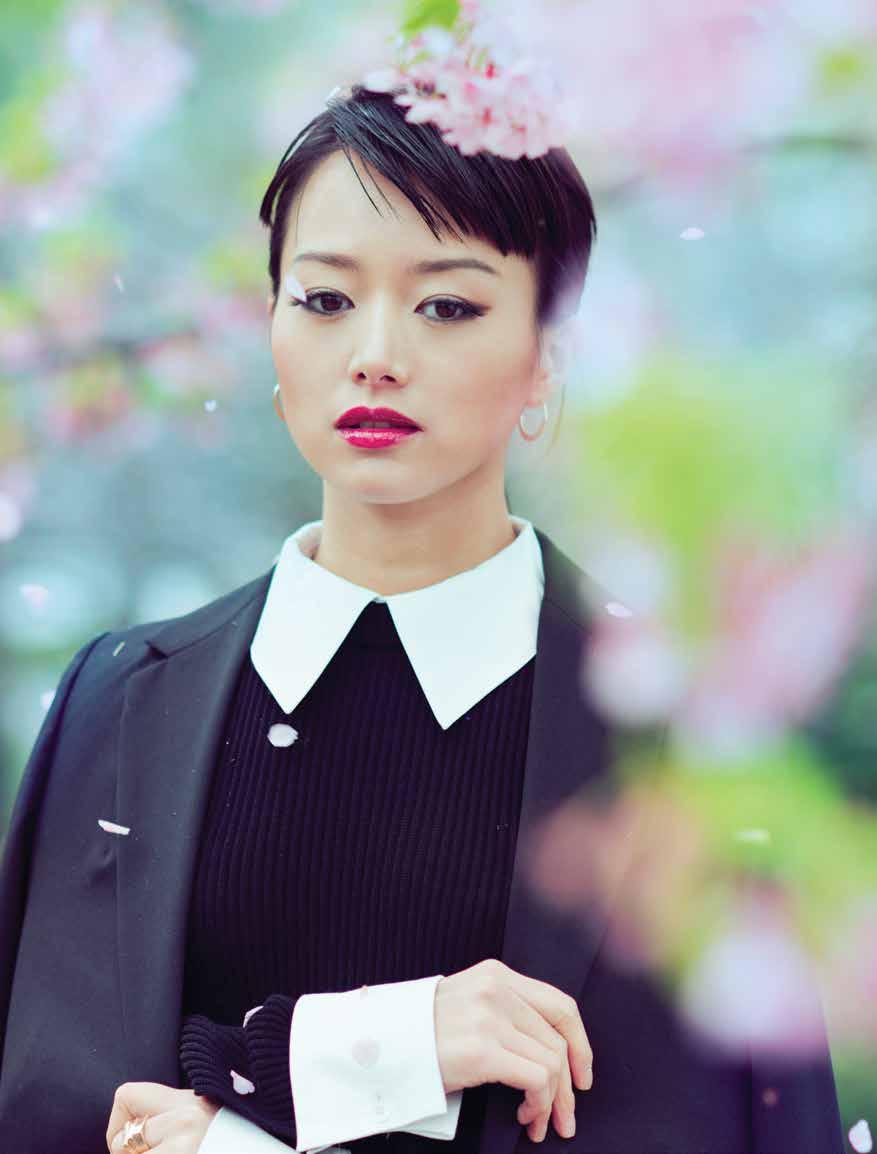
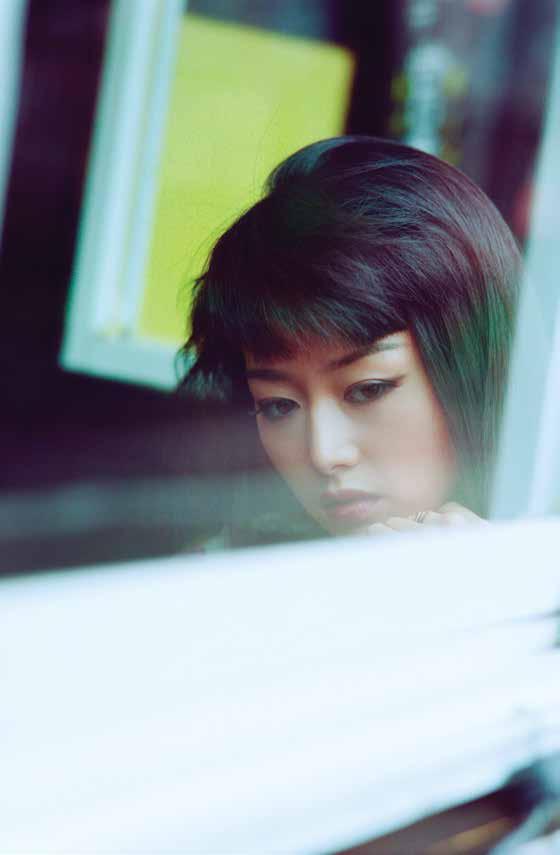
How was it like coming out in Japan?
Kiki: My parents were really supportive when I came out. They are open about these things and had no problem with it. And my friends were like, ‘Oh, we already knew!’, so that was easy, too. My other relatives had a harder time accepting it though, because they were more traditional. But overall, I think I was lucky that I had many supportive people around me, who accepted me for who I was, because that made a huge difference.
What does it mean to be LGBTQ in Japan?
Kiki: I guess it kind of depends on where you live. Being LGBTQ in Tokyo is definitely a very different experience from being LGBTQ in more rural parts of the country. But in general, I think it means that you’re, kind of, not a part of the mainstream in Japan. Except for the entertainment industry, LGBTQ is not really that visible there, you know? It’s a topic people rarely talk about in public. There’s no law that gives equal rights to LGBTQ populations whatsoever, and it’s safe to say that it may not be an easy place to live for the people who want to live openly as LGBTQ. But I feel there are potentially a lot larger LGBTQ populations in Japan — they are probably just hiding their identities or unaware of their true sexuality.
What are some of the nuances you see around Japanese culture/society and LGBTQ issues that people outside the country may not be aware of?
Kiki: Let’s see, I don’t know how much others outside Japan know about LGBTQ issues in Japan but they might not be aware that in Japan, the belief in traditional “gender roles” is still very strong, such as men should work and earn money for his family and women should stay home, do household
chores, and raise kids, etc. I think those kinds of stereotypes make it harder for LGBTQ people to live as a part of the mainstream society there, because we don’t belong in that picture, right?
Also, because LGBTQ presence is not really visible in Japan, many people don’t even know that it even exists. The term “nonbinary” is pretty much nonexistent.
On the other hand, it’s not like in the U.S. or some other countries where LGBTQ people may be fearful of their lives, where they get physically attacked or threatened because of their sexuality. That doesn’t happen in Japan. You’d feel safe there, partly because most Japanese are not religious, and because people generally hide, or don’t talk about their sexuality in public.
What do you enjoy most about the LGBTQ community/culture in Japan?
Kiki: I really enjoy going to lesbian bars. It’s something I don’t see often in the U.S., where you can sit down and talk openly and get close with others. I love that close-knit atmosphere. My favorite place is Bar Gold Finger. It’s a small lesbian bar in Shinjuku 2-Chome, and I really feel at home there.
What are some of the differences and similarities you see in LGBTQ visibility and conversations in Japan and the U.S.?
Kiki: Like I said, LGBTQ is hardly visible in Japan, so I’d say that’s the biggest difference. You almost have to go to specific places to see them, but in the U.S., especially where I live, it’s very visible;
we are everywhere, it’s natural to hold hands or kiss in public. In Japan, that doesn’t happen often either in LGBTQ or heterosexual relationships. I’m not sure if there’s any similarities, it’s just so different in Japan.
How do you see the community evolving in Japan around LGBTQ issues? What kind of changes do you want to see?
Kiki: I think things are changing very slowly, and people are becoming more aware and open to LGBTQ, in part because more people are using social media and have more opportunities to see and learn other ways of life.
I definitely want to see the legalization of LGBTQ marriages in Japan. Also, I really want the government to be more aware of LGBTQ presence and pay more attention to our needs. For instance, you rarely see bathrooms for LGBTQ populations in Japan, or anything for that matter, and I feel that needs to change.
Do you feel that being an actor helps introduce Japan or Japanese culture to foreign audiences?
Kiki: Yes, to a certain degree I believe so. Being an actor in both the U.S. and in Japan, I’m being seen by more audiences and have a platform to speak from.
I recently starred in the series The Terror: Infamy, by Ridley Scott, and my role was a picture bride from Japan. It’s basically a horror story, but it also portrays how the Japanese immigrants and Japanese
128




Americans were put in internment camps during World War II; that’s not widely known in the U.S. or in Japan, especially among the younger generations. So as a Japanese actor I’m honored to play a role where I can highlight these historical events related to Japan, and provide opportunities to learn, not just for Americans but for Japanese as well.
Changing the topic to your favorite activity, traveling. What is your favorite travel memory and why?
Kiki: My favorite place to travel is definitely Okinawa, especially Ishigaki Island. People there are so warm and friendly, and so accepting. Needless to say, the ocean is incredibly beautiful, and I love nature — it’s just such a wonderful place to stay, I absolutely recommend it.
Why do you think people should visit Japan?
Kiki: In Japan, we have very distinctive and unique cultures that are worth exploring. There is so much to see and so much to do. Also, in terms of safety, in Japan, LGBTQ people can enjoy a certain freedom that other countries may not offer, where you can go anywhere, walk around and not feel scared for our safety.
Where have you been recently that really surprised you?
Kiki: OK, so I really love islands and I have visited lots of islands in Japan. I recently went to Awaji Island, which is an island in the south, and there was this small museum called Nazo no Paradise there, which means mysterious paradise. Basically, it was a museum about sex — but not like in a scientific sense or anything, they just displayed a lot of strange, sexual things like huge penises carved out of wood. I really wasn’t expecting that, so I was a bit taken aback but had a good laugh.
132

How would you describe the vibe of big cities in Japan, like Tokyo, Osaka and Kyoto?
Kiki: Let’s see, vibe-wise, you can kind of say that Osaka has a friendly vibe and is more open-minded like LA, and Tokyo has that big-city vibe like New York. I have LGBTQ friends who said they had visited Osaka and had a lot of fun there. But you can probably see more LGBTQ cultures in Tokyo. Kyoto is more like a place where you go and explore the traditional Japanese culture and its heritage. The people in Kyoto value their history and culture highly and have a bit of a closed mentality to outsiders, where sometimes first-time visitors get rejected entries to certain places, regardless of your nationality, sexuality, or ethnicity. But that’s just a part of their custom.
Do you have recommendations for anyone interested in planning to visit Japan?
Kiki: Yes, it kind of depends on the purpose of your visit, but if you are interested in experiencing the Japanese LGBTQ scenes, go check out Shinjuku 2 chome. That’s probably the biggest LGBTQ spot in Japan. They have gay bars, lesbian bars, all kinds of LGBTQ spots that are catered towards different LGBTQ wants and needs. You’ll definitely find something fun and unique there!
134


IMAGES COURTESY OF VIDA MIA 136
TEXT BY MARC GRASER
LADY IN THE WATER
From hosting fashion icons to celebrity royalty, the Vida Mia is one classy yacht that’s always ready to cruise Waikīkī.
For any visitor to Honolulu, seeing the skyline of Waikīkī or majestic Diamond Head from the water is a vantage few get to appreciate unless you surf or strap yourself to a parasail.
There’s a more relaxing option to take in the scenery, however — one that even comes with cocktails or coffee, depending on the time of day.
Beaming in white with lovingly restored teak wood throughout, the Vida Mia is a stunning 61-foot yacht that’s enjoyed the spotlight since 1929. Over the years, it’s been chartered by some impressive guests, including Elizabeth Taylor and Louis Vuitton. More recently, it’s been prominently featured on HBO’s White Lotus
As Hawai‘i’s only commercial wooden luxury yacht, the vessel has provided tourists and locals with an elevated option to cruise Honolulu and explore the Hawaiian islands, while providing a little taste of local culture at the same time.
Throughout the week, the Vida Mia hosts regular sunrise coffee to sunset cocktail cruises, brunches and events with live local music performed on deck that can be purchased as well-priced packages. Individual charters are also available for threehour swim and snorkeling trips or for celebrations, weddings and funerals. It’s certified to cruise with up to 36 passengers.
Down below, the yacht’s surprisingly sizable living space, including a galley kitchen, bathrooms and two staterooms can sleep six and is available for overnight stays that range from two- to seven nights, complete with a captain and crew available to arrange inter-island excursions.






We recommend to start the day with the morning coffee cruise, which the Vida Mia offers through a partnership with the Honolulu Coffee Co., complete with fresh pastries and sunrise views. For the non early riser, there’s House Slippers, featuring an open bar and soulful house music spun by DJ My Friend George on the first Sunday of every month. What could easily be a private plaything is a gem for everyone to enjoy.
“What brings me the most joy is seeing a guest’s reaction when they walk into the salon for the first time,” says Vida Mia owner Brynn Rovito. “A 10 year old child has the same reaction as someone in their ‘80s. They don’t expect it to be so beautiful.”
She almost didn’t end up that way.
Built in Sacramento, the Vida Mia was originally a commuter vessel for wealthy businessmen, and was commandeered during World War II by the United States Coast Guard, painted gray and given a mission to patrol San Francisco Bay for enemy submarines. She arrived in Hawaii in 1961, and was often seen in Maui, but neglected over the years, beaten down by the uncompromising sun and left for years in disrepair.
Its splintered wood, wood-rot-eaten hull and decaying interiors have since been revived to its glorious past. It’s fitting that Vida Mia means “my life” in Spanish, because Rovito has certainly extended it and is happy to share this vintage beauty with the rest of the world.
“I love her lines as she cruises by, her overall aesthetic,” Rovito says. “I love that she lived through so many different eras and survived so many catastrophes. Everyone thinks it's so neat. I love being the person to show them that.”
142


A HUI HOU
Until we meet again










 Photo:
Photo:



















































 TEXT BY EUNICA ESCALANTE
TEXT BY EUNICA ESCALANTE





























 TEXT BY MARC GRASER
IMAGES BY SIHASAK PRACHUM, OSAKA CONVENTION AND TOURISM BUREAU, UNIVERSAL STUDIOS JAPAN, WILLIAM VACCARO
TEXT BY MARC GRASER
IMAGES BY SIHASAK PRACHUM, OSAKA CONVENTION AND TOURISM BUREAU, UNIVERSAL STUDIOS JAPAN, WILLIAM VACCARO























